Nawa Tahir and Jadine Ngan Managing Editor — External and Editor-in-Chief
Content warning: This article contains dis cussions of death, as well as descriptions of gender-based violence and large-scale physi cal violence.
On October 6, over 400 people marched from Sidney Smith Hall to the Ontario Legislative Building in solidarity with the ongoing protests in Iran. The rally was co-organized by U of T

Hundreds march at U of T in solidarity with Iran protests
Current demonstrations connected to a long history of outrage, say speakers
THE VARSITY
The University of Toronto’s Student Newspaper Since 1880
Vol. CXLIII, No. 6October 17, 2022
thevarsity.ca thevarsitynewspaper @TheVarsity
MASTHEAD
the.varsity the.varsity The Varsity
Jadine Ngan editor@thevarsity.ca
Makena Mwenda creative@thevarsity.ca
Nawa Tahir managingexternal@thevarsity.ca
Sarah Artemia Kronenfeld managinginternal@thevarsity.ca
Angad Deol online@thevarsity.ca Managing Online Editor
Talha Anwar Chaudhry copy@thevarsity.ca Senior Copy Editor
Khadija Alam news@thevarsity.ca News Editor
Shernise Mohammed-Ali comment@thevarsity.ca
Editor
Janhavi Agarwal biz@thevarsity.ca Business & Labour Editor
Alexa DiFrancesco features@thevarsity.ca
Editor
Marta Anielska arts@thevarsity.ca
& Culture
Sahir Dhalla science@thevarsity.ca
Editor
Mekhi Quarshie sports@thevarsity.ca
Caroline Bellamy design@thevarsity.ca
Andrea Zhao design@thevarsity.ca
Vurjeet Madan photos@thevarsity.ca
Jessica Lam illustration@thevarsity.ca
Maya Morriswala video@thevarsity.ca
Aaron Hong aaronh@thevarsity.ca
End Web
Andrew Hong andrewh@thevarsity.ca
Safiya Patel deputysce@thevarsity.ca
Lexey
deputynews@thevarsity.ca
Vacant utm@thevarsity.ca
utsc@thevarsity.ca
grad@thevarsity.ca
Protest attendees included those with and without personal ties to Iran. In a conversation with The Varsity at the protest, Rakesh Sengup ta, an assistant professor at the Cinema Studies Institute, said that part of his reason for being there are similarities between women’s autono my in Iran and India. He referred to the backlash that Muslim women in India face for wearing the hijab.
“While the situation is different, I think it’s an is sue about Muslim women’s rights and what they really want… It’s a moment of solidarity,” said Sengupta.
Protest demands
During her speech, Ganji presented a list of de mands, explaining that Iranian people need the U of T community to be their voice and condemn the Islamic regime’s actions. She demanded that U of T offer support to Iranian students trying to escape the oppression in Iran. She further called upon Canadian media to increase its coverage of the situation in Iran, and urged the Canadian government not to normalize diplomatic relations with the Islamic regime.
According to an October 5 statement by U of T president Meric Gertler, the university is pro viding financial support for students in Iran who, while seeking refuge or asylum in Canada, de cide to attend U of T.
Ganji also called attention to the Iranian re gime’s response to recent demonstrations: “This regime has cut off internet access to the country and is violently and criminally cracking down on peaceful protests. Enough is enough.”
Alawi emphasized that Canadians need to support Iranians because Western governments are still working with the Iranian regime. He said that it is “outrageous” that the West hasn’t des
ignated the IRGC as terrorists.
Although the IRGC states that the downing of Flight 752 was an accident, the Ontario Supreme Court ruled in 2021 that the incident had been an intentional act of terrorism.
Alawi further noted that the Iranian regime is sending weapons to Russia for the war in Ukraine. “The fight of Iranian people is the fight of the Ukrainians, and the fight of Ukrainians is the fight of Iranian people,” he said.
In an interview with The Varsity after his speech, Alawi said that the current protests sweeping Iran are “not about small demands. It’s about revolution.”
“Those students could have been us” At Sidney Smith, Shahrzad Mojab — director of U of T’s Women and Gender Studies Institute — said, “Islamization of social, educational, and political life [in] Iran has been enforced through a complex set of ideological and political mecha nisms of coercion.”
Mojab also drew attention to the regime’s vio lence against students. On October 2, students at Tehran’s Sharif University of Technology were holding one of several on-campus sit-ins to call for the release of fellow students who had been arrested during demonstrations. Security forces trapped them inside the gates and then opened fire with rubber bullets and paintballs. “Sharif [University’s] students have called October 2, 2022… a bloody day,” said Mojab.
She reminded attendees that there is a long history of violence against students in Iran. In 1953 Richard Nixon, then-vice president of the US, visited Iran to receive an honorary degree from Tehran University. Tehran University stu dents protested his visit on December 7, 1953; to disperse the crowd, the Iranian police entered
the university and fired on the students, causing three student deaths.
Mojab urged the U of T community to com memorate December 7, 2022 by organizing a student rally to mark 69 years of students’ strug gle for freedom in Iran.
Alawi’s speech also made reference to the events at Sharif: “Those students could have been us, and we could’ve been them,” he said.
Kelly Hannah Moffatt, U of T’s vice-president, people strategy, equity & culture, released a public statement on September 27 affirming that campus protests and vigils for Amini have the university’s support.
The importance of sustained action In an interview with The Varsity, protest co-orga nizer Sara Shariati emphasized that the move ment in Iran is ongoing. “I am very happy from the bottom of my heart that people came out and supported this [event], but this is not the end.”
Shariati, who is pursuing her MSc at U of T, said that she had struggled to decide which names of the dead to include in her speech.
“When you can’t fit the names of the people who have been killed and murdered in one speech, just this alone shows how big this movement is.”
She called for events every week, adding that action must continue “as long as people in Iran are fighting.” She also expressed her pride in the current movement and the “Woman, Life, Freedom” message. “If there was any time for a revolution in Iran — and if there is any message for revolution — I think this is the one we want.”
“We don’t want to be the ones who are scared. The regime’s scared now.”
See support resources page 3.
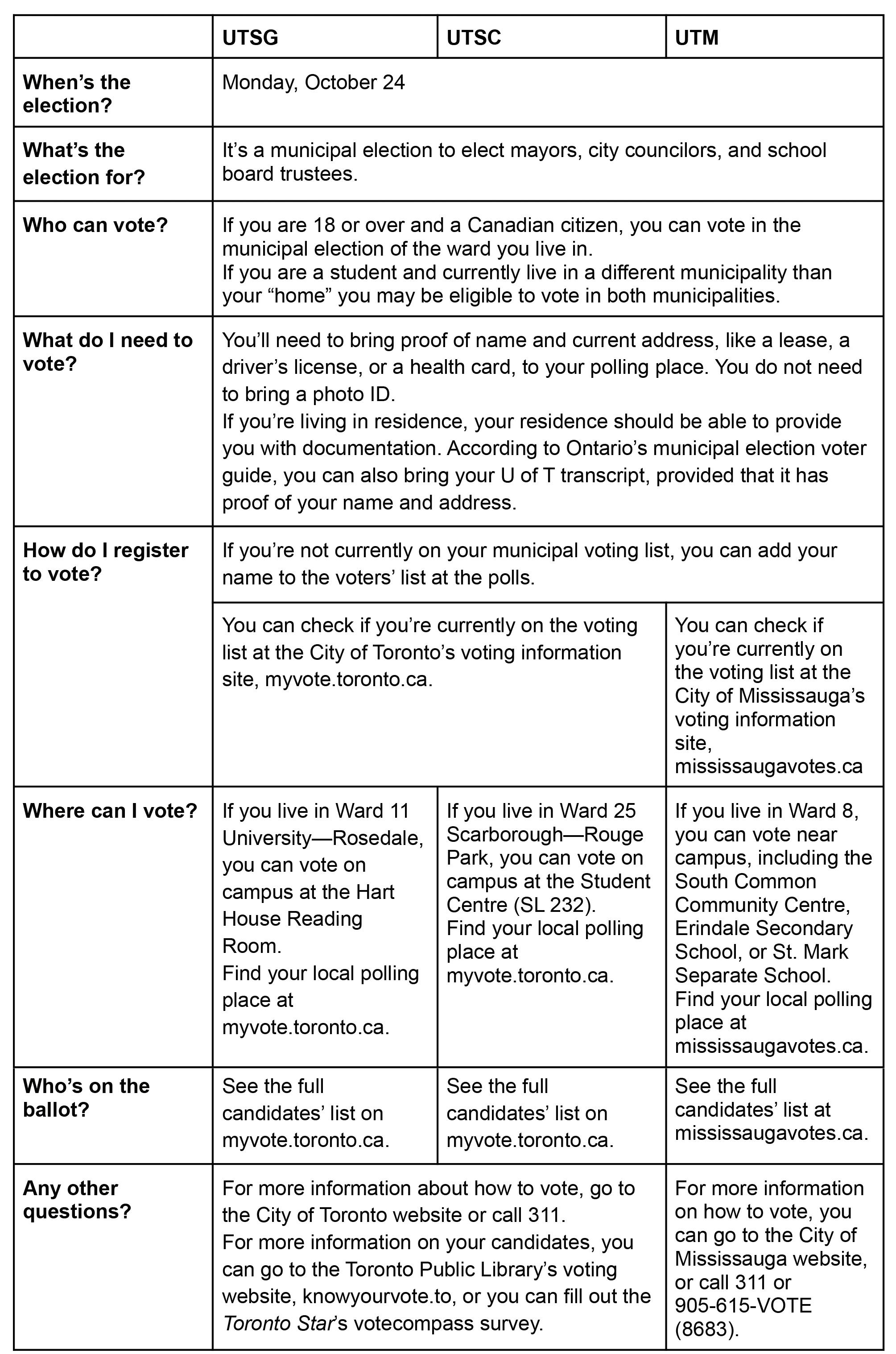
Zeynep
Vacant
Ishir
Rania
Abdulmunem
BUSINESS OFFICE
ishirw@thevarsity.ca
atartir@thevarsity.ca
A student’s guide to the municipal election
CORRECTIONS: In issue 5 of The Varsity, a
article titled “U of T community criticizes fraternity’s 69th luau” incorrectly implied that there is a formal connection between the fraternity and the university. The article has been updated to clarify that the fraternity simply has a branch for U of T students. An arts article titled “Finding a voice through storytelling at the 15th annual Toronto Palestine Film Festival” incorrectly referred to the Toronto Palestine Film Festival as the “Toronto
Film Festival.”
A comment article titled “U of T’s surplus of profits should be spent on survivors of sexual violence and harassment” incorrectly stated that the SVPSC created U of T’s Policy on Sexual Violence and Harassment, and was responsible for the policy’s review. In fact, the university was responsible for both the policy and the review, and the SVPSC simply plays a role in implementing the policy.
CREDIT: Special illustration thanks to Christina Dinh.
news@thevarsity.ca2 THE VARSITY NEWS 21 Sussex Avenue, Suite 306 Toronto, ON M5S 1J6 (416) 946-7600 Vol. CXLIII, No. 5 THE VARSITY THE VARSITY Lead Copy Editors Ozair Chaudhry, Linda Chen, Jevan Konyar, Kyla Cassandra Cortez, Bella Reny, Lucas Saito, Nandini Shrotriya, Kiri Stockwood, Lina Tupak-Karim, Valerie Yao Copy Editors Naomi Altwasser, Kamilla Bekbossynova, Gene Case, Tiana Milacic, Eleanor Park, Biew Biew Sakulwannadee, Ishita Sharma, Camille Simkin, Lucy Spencely, Grace Xu, Junella Zhang Designers Songzi Zhou The Varsity is the University of Toronto’s largest student newspaper, publishing since 1880. It is printed by Master Web Inc. on recycled newsprint stock. Content © 2021 by The Varsity All rights reserved. Any editorial inquiries and/or letters should be directed to the sections associated with them; emails listed above. The Varsity reserves the right to edit all submissions. Inquiries regarding ad sales can be made to ads@thevarsity. ca. ISSN: 0042-2789
Parmis Mehdiyar business@thevarsity.ca Business Manager
Wadhwa
Business Associate
Sadik raniasadik@thevarsity.ca Advertising Executive
Aboud Tartir
Advertising Executive
Editor-in-Chief
Creative Director
Managing Editor, External
Managing Editor, Internal
Comment
Features
Arts
Editor
Science
Sports Editor
Design Editor
Design Editor
Photo Editor
Illustration Editor
Video Editor
Front
Developer
Back End Web Developer
Deputy Senior Copy Editor
Burns
Deputy News Editor
UTM Bureau Chief Alyanna Denise Chua
UTSC Bureau Chief Emma Livingstone
Graduate Bureau Chief Vacant publiceditor@thevarsity.ca Public Editor Ajeetha Vithiyananthan Associate Senior Copy Editor Alana Boisvert, Selia Sanchez, Jessie Schwalb, Tony Xun Associate News Editors Isabella Liu, Eleanor Park Associate Comment Editors Alice Boyle, Maeve Ellis Associate Features Editors Madeline Szabo Associate A&C Editor Vacant Associate Science Editor Alya Fancy Social Media Manager Kunal Dadlani Associate Sports Editor Georgia Kelly, Andrew Ki Associate B&L Editors Arthur Hamdani, Johanna Zhang, Spencer Lu Associate Design Editors Cheryl Nong, Biew BiewSakulwannadee Associate Illo Editor
Poyanli, Nicholas Tam, Augustine Wong Associate Photo Editor
Associate Video Editor
news
Palestinian
“There is outrage before grief”: Iranian community gathers at Multi-Faith Centre for vigil
Jadine Ngan Editor-in-Chief
Content warning: This article contains dis cussions of death, as well as descriptions of gender-based violence and large-scale physi cal violence.
On October 3, approximately 150 members of the Iranian community and allies at U of T gathered on the second floor of the UTSG Multi-Faith Centre for a tri-campus community vigil. The Iranian Association at the University of Toronto (UTIRAN), the Anti-Racism and Cultural Diversity Office, and the Multi-Faith Centre co-organized the event to help the community gather and reflect as widespread demonstrations continue in Iran.
The ongoing wave of demonstrations began after 22-year-old Mahsa Amini died in custody in Tehran, Iran on September 16, after ‘moral ity police’ arrested her for violating the coun try’s mandatory dress code. In the weeks since Amini’s death, protests for freedom from the Iranian regime have gained momentum, both within Iran and across the world. In response, the regime has orchestrated a brutal crack down, paired with internet and social media blackouts that have significantly impaired com munication.
In light of these events, senior U of T ad ministration attended the vigil to offer remarks of solidarity and support. Following these speeches, the organizers invited attendees to engage with each other. For the next 40 min utes, members of the Iranian community at U of T came together in a conversation demand ing justice and support and expressing their outrage at the situation.
The vigil was livestreamed online for those who could not attend in person. An overflow room displaying the livestream was also avail able on the first floor of the building.
Remarks from U of T administration Senior administration addressed the univer sity’s Iranian community at the vigil. Remarks were provided by Vice President, Human Re sources and Equity Kelly Hannah-Moffatt; Vice Provost, Students Sandy Welsh; and Execu tive Director, Equity, Diversity & Inclusion Jodie Glean.
Sandy Welsh, Vice-Provost Students, ex pressed deep sadness over Amini’s death. She recognized the “many emotions” that attend ees might be feeling, and encouraged strug gling community members to reach out. “The university is here to support you,” she said.
Kelly Hannah-Moffatt — vice-president, hu man resources and equity — told attendees that the university leadership stands with them. “Here in Canada, we cannot be complacent. It remains as important as ever for us to speak out and to continue working to protect the very precious freedom to make choices,” she said.
Several days before the vigil, Hannah-Mof fatt released a statement addressing Amini’s death and affirming the university’s support for protests and vigils honouring Amini.
Following Hannah-Moffatt’s speech, a repre sentative of UTIRAN led the room in a moment of silence, accompanied by a candle-lighting ceremony.

Finally, Jodie Glean — executive direc tor, equity, diversity & inclusion — expressed solidarity with the Iranian people’s calls for change. “We all have the right to be, to live, to grow older, to walk the streets of our cities or to commute through the streets of our cities [and] of our universities, and be able to make it home to our families at the end of the day.”
“Our fights are inextricably linked. I need not
be from the same place or be of the same cul ture to understand your pain,” Glean, who is from Grenada, added.
Calls for justice
Glean closed her speech by opening the floor up to the community. Second-year PhD student Niloofar Ganji — who co-organized the September 22 vigil outside Convocation Hall with U of T PhD student Faraz Khoshbakhtian — led attendees in a chant of “Zan, Zendegi, Azadi: Woman, Life, Freedom” before sharing her thoughts.
“Zan, Zendegi, Azadi” is the Farsi translation of “Jin, Jiyan, Azadi,” a Kurdish slogan with roots in the Kurdish Freedom Movement of the twentieth century. In the early 2000s, the Kurdish women’s movement adopted the slogan, and now, the words have become a rallying cry for the current protests in Iran.
Addressing the room, Ganji likened Amini to her sister, saying, “If I was attending, af ter three weeks, the mourning of my sister, I would like to hear the words ‘murder,’ which is what happened to her. I would like to hear the words ‘murderer,’ which is who killed her — and I would like to recognize who that mur derer was.”
“I did not hear any of those in this gather ing. And that’s why I’m not feeling any release,” Ganji added.
The police reportedly beat Amini in the head with a baton and slammed her head into a ve hicle. The 22-year-old Iranian Kurdish woman was then taken to Vozara Detention Centre, where she collapsed and fell into a coma before her death.
Iran’s coroner has attributed Amini’s death to underlying illness. However, her father — who caught a glimpse of bruises on her body ahead of her funeral — insists that the police are re sponsible for her death.
Amini’s death was not the only one that at tendees addressed. Several community mem bers showed up to the vigil with signs displaying the names and faces of a dozen other people identified as having been “Killed by the Islamic Republic Regime.” Among them was 16-yearold Nika Shahkarami, whose mother says she died from blows to the head during a late Sep tember protest in Tehran. Authorities say Shah karami died after falling from a tall building.
“We are not grieving, we are asking for jus tice. You can grieve only once you have justice,” another attendee said, emphasizing that the community had gathered for condemnations and not “candle ceremonies.”
Addressing the event speakers, they added, “We didn’t hear a single word of condemnation from you today. Bring shame on you.”
On October 5, two days after the vigil, U of T President Meric Gertler released a state ment condemning “the systemic violations of the rights of women that led to Mahsa Amini’s death.”
U of T and the responsibility of academic institutions
Several vigil attendees demanded action from U of T, emphasizing the power that the university holds as a prestigious post-secondary institu tion with a generous endowment and extensive influence. According to the most recent Endow ment Report, the university’s estimated total endowment value for 2021–2022 was over $3 billion.
“Studying has been a side thought... I couldn’t care less if I failed my next test. My brethren and sisters are dying on the streets to free themselves from 43 years of oppression,” one community member said. They added that, with meaningful support from the university,
“We could make a difference.”
According to Iran’s Human Rights Activists News Agency, as of October 16, approximately 240 people have been killed in Iran during the protests, which are still ongoing across the en tirety of the country. The actual death count remains unclear because of Iranian authorities’ suppression of information.
Another community member expressed frus tration that they had not seen professors ac knowledge the situation in Iran. “We work for them. We publish for them. Where are they right now?”
Multiple attendees also made reference to the previous day’s violence at the prestigious Sharif University of Technology in Tehran. The afternoon of October 2, the Basij — a plain clothes militia force — trapped students behind the gates of Sharif during one of several silent student-led sit-ins.
The Basij then opened fire on the students using paintballs and rubber bullets, and violently beat professors who tried to protect students. “We thought they were going to kill us,” Mahan, a 25-year-old engineering student, told the New York Times. According to the Islamic Associa tion of Students of Sharif University, at least 30 students were arrested.
“What happened last night at Sharif was an attack on the whole world of academia,” said event attendee Sara Shariati, who co-organized the October 6 protest at UTSG and is pursuing a MSc in molecular genetics at U of T. “Before it was women’s rights, now it’s also students’ rights.”
In addition, community members highlighted U of T’s specific connection to the violence of the Iranian regime via Flight 752. Iran’s Islamic Revolutionary Guards Corps (IRGC) shot the Ukraine International Airlines flight down via surface-to-air missile on January 8, 2020. The IRGC, while independent of Iran’s army, is a branch of the country’s armed forces.
Among the 176 people who died on Flight 752, there were eight U of T community mem bers, including six students. The crash left no survivors.
Ganji told the room that people from her pro gram had been on the downed flight. “It could be me, standing right here. It could be my boy friend, standing right there. Any of my friends — any of you guys in this room — any of us could be on that plane. That’s how close it was to us.”
“My grandparents were actually supposed to be on the Ukrainian flight,” another attendee told the room. “They got lucky to be booked on another flight.”
In an email to The Varsity, a U of T spokesperson affirmed that the university “remains deeply concerned about the situation in Iran and recognizes that it is an extremely difficult time for many members of the University community, particularly those with ties to Iran.”
For students from Iran interested in attending
U of T while seeking refuge or asylum in Cana da, Gertler’s statement confirmed that bursaries will be available via the Scholars at Risk Award Program. He also stated that the Iranian Stu dent Memorial Scholarship Fund, which was established in 2020, will continue to provide financial aid to international students from Iran.
Call for support from non-Iranians
In an interview with The Varsity after the vigil, a student leader from UTIRAN — who asked to be identified only as an UTIRAN spokesperson due to safety concerns — asked for solidarity from the rest of the university community. “Come out, recognize the situation, and understand what the Iranian community is going through at the moment,” they said.
Shariati also called for support from non-Ira nians, emphasizing to The Varsity that Iranian students engage in advocacy at significant risk.
“I don’t know if I can go back to my country after speaking up,” she said during an interview.
Shariati, who completed her undergraduate degree in global health and molecular genetics at U of T, lived in Iran before she came to Cana da seven years ago. “Those are my high school friends, schoolmates, who are dying,” Shariati told The Varsity
“I haven’t talked to my family for seven days or more, because I can’t contact them. I don’t know who has died, who has lived,” Shariati added, explaining that she cannot step away from the news because internet blackouts make it difficult to receive updates about loved ones any other way.
“I think I can speak on behalf of the majority of the Iranian community that we haven’t slept, we haven’t eaten,” Shariati said. “We haven’t had a moment to even breathe, because there is outrage before grief.”
Due to the nature of the event, The Varsity was unable to obtain the names of some attendees quoted in this article.
If you or someone you know is in distress due to the ongoing situation in Iran, you can contact:
• The Iranian Women’s Organization of On tario at (416) 496-9566 or info@iwontario. com,
• Wellness Care Counselling — which is of fering free single-session therapy for Ira nian individuals 16 years or older living in Ontario — at info@wellnesscarecounsel ling.com,
• U of T’s Anti-Racism and Cultural Diversity Office at (416) 978-1259 or antiracism@ utoronto.ca, and
• U of T’s My Student Support Program — available 24/7 — at (844) 451-9700 if you’re in North America, or at 001416-380-6578 if you’re outside of North America.
thevarsity.ca/section/news OCTOBER 17, 2022 3
Attendees call for support from non-Iranians as demonstrations continue in Iran
A candle lighting ceremony for Mahsa Amini took place at the Multi-Faith Centre. JADINE NGAN/THEVARSITY
Ward 11, University–Rosedale council candidates
No incumbents running, Ward 11 race expected to be competitive
Emma Livingstone Graduate Bureau Chief
On October 24, residents of Toronto will be voting in the latest municipal election. After current city councillor Mike Layton decided not to run for reelection, there are now 14 new names on the ballot for Ward 11’s city council.
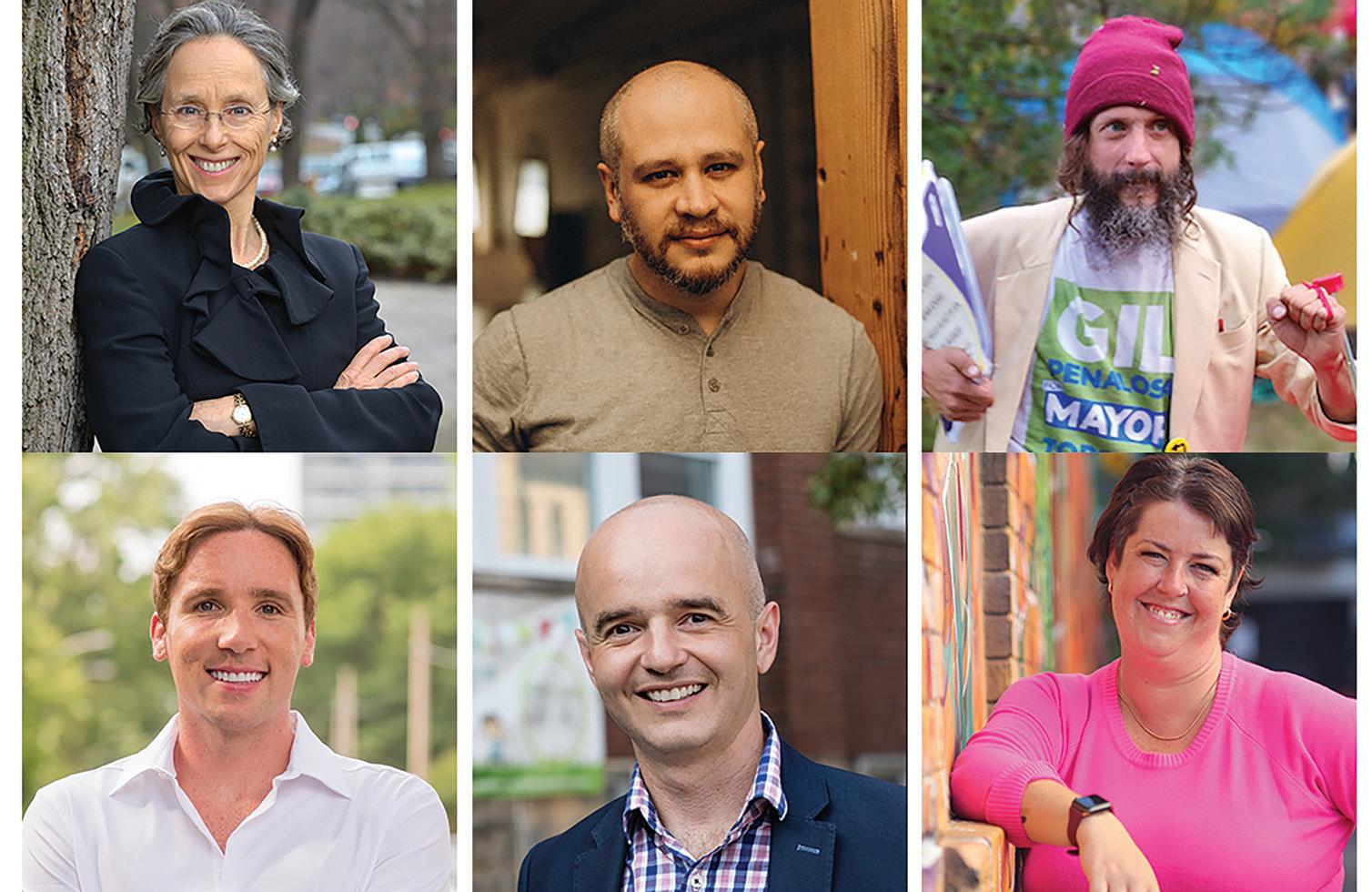
Axel Arvizu
Axel Arvizu wrote in a statement to The Varsity that he was inspired to run for city council after initially planning to move out of Toronto because of affordability concerns until the COVID-19 pandemic impacted those decisions. “We were essentially being driven out of our own city by the housing crisis,” he wrote. He is running on a platform based on housing affordability, access to transit or alternative transportation, and community safety.
“Young generations are facing an unprecedented amount of obstacles in this city,” Arvizu wrote. He promised that, if elected, he would prioritize making time to address questions and concerns from constituents.
Robin Buxton Potts
Robin Buxton Potts is the current interim councillor for Ward 13, Toronto Centre. She is filling in for former city councillor Kristyn Wong-Tam, who was elected to the provincial government in June 2022.
Potts has served as chief of staff in WongTam’s council office and is promoting her previous experience in her campaign.
In an email to The Varsity, she highlighted key aspects of her platform, including commitments to regular accessible transit, availability of affordable housing, and improved neighbourhood maintenance, including parks preservation, repairs to water fountains, and snow maintenance.
“It is unacceptable to me that students are Travelling over an hour to get to class or staying in shelters or are living in unsafe, rooming houses
across the city because the city government has not created enough space for them,” she wrote in the email.
Norm Di Pasquale
Norm Di Pasquale has served as a trustee for the Toronto Catholic District School Board in Ward 9 since 2018. He also previously ran for MP as the New Democratic Party candidate in Spadina— Fort York. His platform’s top priorities include commitments to housing for all, improving public services, and increasing the accessibility of parks and other public spaces.
In an email to The Varsity, Di Pasquale wrote that he would work to improve issues important to students such as housing affordability and mental health services. “I have seen the state of our City, and we need to do better. Services are not working for residents, Toronto is as unaffordable as ever, roads are not as safe as they need to be, and we are still lacking the meaningful climate action that will make us a world leader,” he wrote.
Di Pasquale has been endorsed by outgoing Ward 11 councillor Layton.
Adam Golding
Adam Golding is a U of T alum and candidate for the Municipal Socialist Alliance, which has a collective platform of providing assistance to those facing homelessness, advocating for free transit, and enacting climate action. Golding previously participated in municipal political issues, including supporting unhoused people camping in Lamport Stadium Park who were facing eviction from the city.
According to Durham Radio News, Golding was arrested at Lamport for police obstruction. He later wrote on Twitter that the charges against him had been dropped.
In a statement to The Varsity, Golding wrote that his platform is “laser-focused on the cost-of-living in the short-term,” as well as “expand[ing] the arts.” He highlighted that he is the “only candidate with sheet music as part of their campaign materials… which I distributed to every office in the music faculty.”
Andrew Layman
Andrew Layman wrote in an email to The Varsity that he was inspired to run for city council to make his home ward more accessible and affordable. His platform centres on housing affordability, creating an accessible community, and increasing street safety and road shareability. “Housing affordability impacts us all, but students and young people arguably face the most hardships due to the skyrocketing costs of housing,” he wrote.
“The city as it currently stands has become increasingly unaffordable and young people and students are often priced out of the city. Worst, young people, students, and people of colour are oftentimes forced into homelessness,” he added.
Dianne Saxe
Dianne Saxe is an environmental lawyer who also served as the Ontario Environmental Commissioner from 2015–2019. Her platform focuses on affordable housing, environmentally sustainable modes of transportation, repairing city services and infrastructure, and climate action.
“The climate crisis is of overwhelming importance to young people because it will colour so much of their lives,” Saxe wrote in an email to The Varsity. She also described goals to increase opportunities for active transportation, which includes biking and walking, as well as create
“missing middle” housing to develop “15 minute neighbourhoods” — neighborhoods where most necessities are “within 15 minutes of their homes.”
Pierre Therrien
Pierre Therrien plans to run for city council as part of a larger plan to run for premier of Ontario. In an email to The Varsity, Therrien wrote that one of his main reasons for running for office was “to highlight the underfunded conditions at our nuclear energy facilities, and bring this issue to the provincial legislature.” Therrien explained that the rest of his platform includes climate change initiatives such as a carbon tax and free transit.
He has previously posted on Twitter that he believes “Every Canadian, born in Canada, is Indigenous to Canada.”
The Varsity could not reach candidates Michael Borrelli, Peter Lovering, Heather Shon, and David Fielder for comment.
Diana Yoon, Alison Pang, and Ann Rohmer have withdrawn from the race, but their names will still appear on the ballot.
Election day for Toronto’s municipal election is October 24, 2022. To find the candidates for your area and how you can cast your ballot, visit the City of Toronto’s website.
The Breakdown: John Tory’s third reelection campaign
John Tory’s campaign focuses on transit, housing, Toronto film industry
Selia Sanchez Associate News Editor
On October 24, residents of Toronto will vote to elect the City of Toronto’s mayor and city councillors for the next four years. Incumbent Mayor John Tory is currently up for reelection, seeking his third consecutive term. Including Tory, a total of 31 candidates registered to run in the upcoming election.
Tory, who was initially elected in 2014 and then reelected in 2018, announced his intention to run for office again on May 2.
The Varsity broke down Tory’s re-election campaign and considered his campaign promises on housing affordability, transit, and Toronto’s economy, as well as his plans regarding COVID-19 safety.
COVID-19
At this point in his campaign, Tory has not revealed a plan to combat the spread of COVID-19.
Commenting on Tory’s leadership throughout the pandemic, Crognali explained that he has “led Toronto to world-leading vaccination rates in our city.”
As of October 13, the City of Toronto has administered a total of 7,543,704 COVID-19 vaccine doses, and 2,761,963 Toronto residents have received at least one dose.
Crognali affirmed that Tory is “committed to continuing to work with municipal public health experts, as well as the provincial and federal governments, to protect the public against COVID-19.”
Public transit
On September 20, Tory reaffirmed his commitment to the $28 billion transit plan that the government of Ontario had proposed in 2019.
Following the provincial government’s announcement of the transit plan, Tory expressed his approval of the plan and said, “It is important to see the province of Ontario making a long-term, multi-billion investment in building transit in Toronto and in the GTA.”
The proposed plan involves the construction of four subway lines, including the Ontario Line, the Scarborough Subway Extension, Eglinton Crosstown West Extension, and the Yonge North Subway Extension. The project also includes the construction of the Hamilton Light Rail Transit. The province began construction in 2021.
Tory added, “One of the big reasons why I’m seeking a third term as Mayor is to make sure the once in a lifetime transit expansion gets done.”
Moreover, Crognali explained that Tory has demonstrated his commitment to ensuring affordability and accessibility on the Toronto Transit Commission (TTC) throughout his current and previous terms as mayor of Toronto. She specifically referenced the Fair Fare Pass program that Tory launched in 2018. The program provides eligible low-income residents with a discounted price on TTC fares. However, some transit advocates have criticized the program for not being broad enough. Shelagh Pizey-Allen, executive director of TTCriders, said to the Toronto Observer, “It’s a shame that the program was not expanded this year to all low-income Toronto residents.”
Housing affordability
As part of his campaign, Tory announced a “Five Point Plan” to get houses built faster and tackle affordability issues in Toronto.
Crognali wrote, “The plan is about making sure that young people can afford to live in the city, and can live and raise their families in the neighbourhoods [that] they grew up in.”
Tory’s plan consists of five pillars: expanding housing options; creating a Development and Growth Division to speed up construction approvals for residential buildings; requesting the province to allow the City to establish a “use it or lose it” policy in order to ensure residential construction projects are carried out in a timely manner; allowing nonprofit organizations to develop co-op housing; and allowing the construction of purpose-built rental housing.
On his campaign site, Tory wrote, “Under my leadership, over the past eight years, Toronto has made strong progress on getting homes built, especially affordable and supportive housing.” However, he acknowledges that “there’s more work to do.”
On September 21 alone, 8,209 people occupied spaces in Toronto’s shelter system. According to Fred Victor — a Toronto-based organization advocating for affordable housing in Toronto — on any given night, there are more than 10,000 individuals homeless in Toronto. Additionally, on any given night, homeless shelters in Toronto are at 98 per cent capacity.
In his run for a third term, Tory said that “Canada is facing a national housing shortage… We know that when there’s not enough housing, it becomes more expensive for everyone.” Recently,
U of T students have been struggling with high rent prices, over-capacity student residences, and landlord disputes.
Economy
In light of the 47th Toronto International Film Festival, held between September 8 and September 18, Tory announced that, if reelected, he will expand the film, television, and digital media industry by one billion dollars and support 20,000 new workers in the industry.
On his campaign site, Tory noted that during his two terms as mayor, he has prioritized “the growth and success of [the] tremendously important [film, television, and digital media] industry.” He added that he strongly believes that “the film, television and digital media industry will continue to play an important role in [the economy of Toronto].”
To further the goal of growing the industry in Toronto, Tory announced a plan with four priorities. He proposes to focus on film production infrastructure, diversification and training for talent in Toronto, sustainable improvements to industryrelated technology, and growing the industry in Toronto by encouraging residents to take pride in having a creative industry reflective of the city’s diversity.
On September 11, Tory announced another economic commitment of his campaign and promised to keep taxes low for residents of Toronto, if reelected as Toronto’s mayor. This decision has been controversial, as some residents are concerned about the state of social programs if taxes remain low.
This article has been shortened for print. The full version can be found online at thevarsity.ca.
news@thevarsity.ca4 THE VARSITY NEWS
In clockwise order: Dianne Saxe, Axel Arvizu, Adam Golding, Andrew Layman, Norm Di Pasquale, Robin Buxton. COURTESY OF DIANNESAXE, AXEL ARVIZU, ADAM GOLDING, ANDREW LAYMAN, NORM DI PASQUALE, ROBIN BUXTON
“Too Little Too Late”: PEARS Project protests U of T’s sexual violence policy response

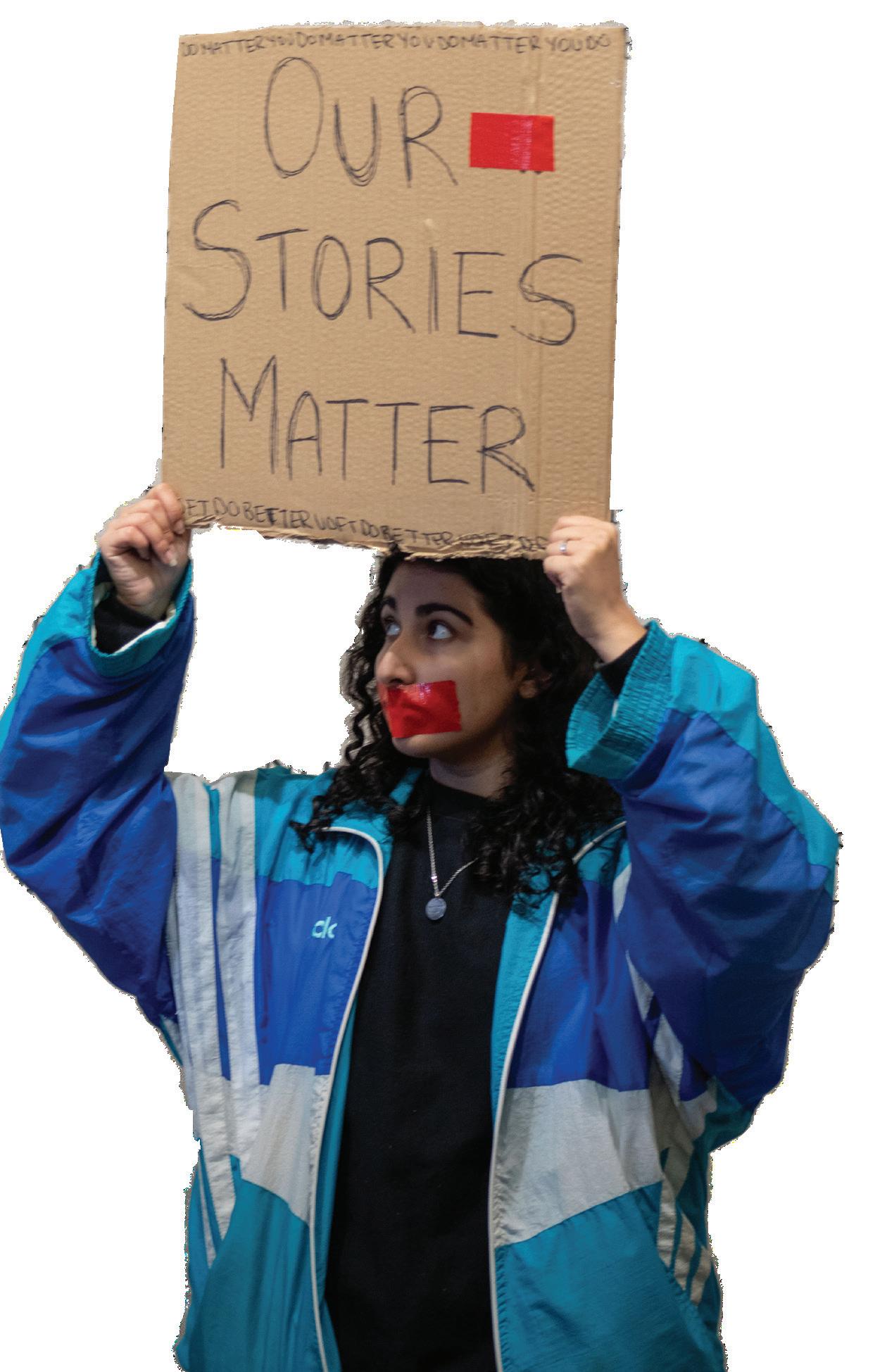
Students participated in a silent sit-in outside president’s office
Jadine Ngan, Nawa Tahir, Lexey Burns Varsity Editors
On October 7, the Prevention, Empowerment, Advocacy Response for Survivors (PEARS) Project — a U of T student-led, trauma-informed initiative supporting survivors of sexual violence — organized a protest against U of T’s acceptance of sexual violence policy review recommendations.
The event, titled “Too Little Too Late,” took place three months after the university accepted all 12 recommendations from the most recent review of the university’s Policy on Sexual Violence and Sexual Harassment.
At the event, which was supported by the University of Toronto Students’ Union (UTSU), the UTM Students’ Union (UTMSU), and the Scarborough Campus Students’ Union (SCSU), protestors marched through campus then staged a silent sit in outside the office of U of T’s president. Following the sit in, survivors of sexual violence shared their stories with attendees.
U of T’s sexual violence policy details procedures and supports for incidents of sexual violence affecting members of the university community, and must be reviewed every three years according to provincial legislation.
Micah Kalisch, the founder and director of PEARS, has previously expressed concerns that the recommended changes complicate the reporting process for survivors, and do not provide enough survivor support.
In September, PEARS held a “Chalk is Cheap” event to raise awareness about the ‘red zone’ — a term which is used to refer to the prevalence of sexual violence in the first few weeks of universities’ academic years.
The protest
The event opened with sign making on Philosopher’s Walk, directly outside the Faculty of Music. Last summer, allegations of sexual harassment against professors in the Faculty of Music came to light when student and labour unions posted them on social media. In August 2021, Canadian Union of Public Employees, Local 3902 posted signs along Philosopher’s Walk detailing survivors’ experiences of sexual harassment in the Faculty of Music.
From Philosopher’s Walk, the protesters marched toward Simcoe Hall. On the way, they stopped outside Trinity College, where Andy Orchard — against whom allegations of sexual harassment were published by Al Jazeera last year — served as provost for six years. Orchard was a medieval studies professor at U of T for 13 years. In 2013, he left for the University of Oxford, where he still teaches.
Outside Trinity College, Kalisch told the protestors that after U of T received complaints of sexual harassment against Orchard, “instead of doing something about it, he was promoted to the provost of Trinity College.”
Kalisch also mentioned that Orchard’s portrait hung in the Trinity College dining hall until last year.
Kalisch then led the protestors in a chant as they continued to march: “Your policies are broken. Survivors have spoken.” The group headed south along St. George Street toward Simcoe Hall, where the office of U of T President Meric Gertler is located.
Once outside Simcoe Hall, protestors initially found the front doors locked. After several attempts to get into the building, the crowd managed to enter through the front door and sat silently at the base of the first floor stairs. Some protestors, including Kalisch, stuck red tape over their mouths to symbolize the administrative red tape that complicates reporting processes.
Kalisch then led protestors up the stairs to the president’s office, where the group sat for just under an hour. Protestors wrote their demands on sheets of printer paper, which Kalisch then slipped
under the president’s closed door.
Afterward, the protest moved back outside Simcoe Hall. Organizers invited several attendees to address the crowd from the building’s front step. UTMSU President Maëlis Barre and SCSU President Michael Sobowale offered remarks of support and solidarity. Other speakers, including Bec Brydon and Radhika Gupta — PEARS’ outreach director and a leader of UTSC’s PEARS branch, respectively — shared stories of their experiences with sexual violence at U of T.
In an interview with The Varsity, Gupta acknowledged that, despite the turnout at the protest, there are many more survivors at U of T whose experiences are overlooked by the system. She emphasized that PEARS is only a message away: “We may not have all the answers, but we can promise that no one has to go through any of this alone ever again,” she said.
Protest demands
In keeping with the name of the event, Emma Biamonte — policy projects lead at PEARS and co president of the initiative’s University College branch — criticized the final report recommendations for being “too little too late.” In a speech, she noted that the university performed the review internally rather than entrusting it to an external body, and expressed concerns with the report’s non-committal language and insufficient incorporation of community feedback.
She also drew attention to recommendation seven of the review, asking, “How can the school be implementing formal supports for respondents when survivors are failing to access any kind of necessary support or accommodation?”
In August, Kalisch told The Varsity that recommendation seven of the review, which involved formalizing supports for those facing allegations, “really raised some flags about the prevalence of professors and faculty being accused of sexual violence.”
Kalisch, addressing protest attendees, acknowledged that many of the people present were survivors themselves. “For many of us, this isn’t just about a policy review,” Kalisch said. “This isn’t just about the practices that the university puts forward. This is about our lives, and this is about our safety, and this is about our dignity.”
Kalisch also highlighted that U of T’s student feedback form for the review closed for submissions on the day of the protest, October 7, at 5:00 pm, a deadline that they felt was
Gharbiyeh from the UTSU — attended the protest.
Gharbiyeh told The Varsity that he believes the review’s recommendations are inadequate because they do not respond to criticisms from survivors and other students who had been consulted. “If anything, some of [the recommendations] seem to be going in an adverse direction,” he said.
He explained that the UTSU has been working with the PEARS project since the start of last term, and some members of the union attended the event as a gesture of solidarity. He believes it’s important that students know the union is “hearing their concerns even if the administration isn’t.”
Prior to the event, the UTMSU and SCSU offered information and resources to help satellite campus students attend the protest. The UTMSU pointed students to the UTM shuttle bus service and the SCSU offered PRESTO passes for Scarborough students.
Barre explained that she believes showing up to the event in person is more meaningful than an online statement or post: “It shows the strength in numbers. It shows the support that students have from their union and from each other.”
Barre said that the UTMSU will request to speak at the policy review later this year at the Governing Council.
In an email to The Varsity, Sobowale wrote that the SCSU attended the protests because students “have the right and ability to voice their displeasure in the most appropriate avenue, which is not limited to protests but making sure our actions also show what we believe in.”
U of T’s response
In an email to The Varsity, a U of T spokesperson stated that the university’s Policy on Sexual Violence and Sexual Harassment is intended to outline how the university responds to reports of sexual violence involving the U of T community, and to provide supports for those who have experienced sexual violence.
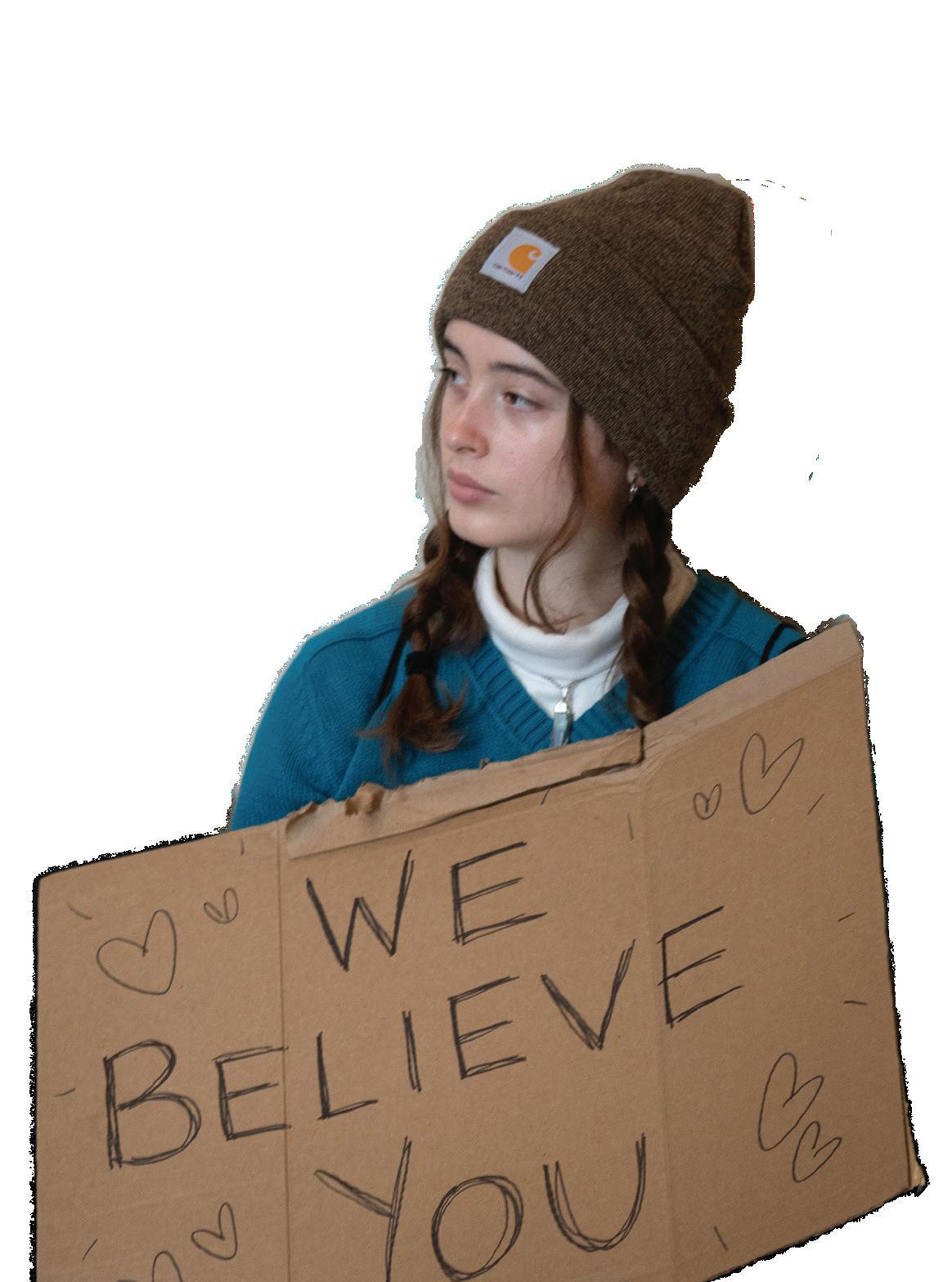
They explained that the policy, which applies to all students, staff, faculty and librarians, is “an important component of the University’s commitment that all members of the University community should have the ability to study, work, and live in a campus environment free from sexual violence, including
sexual harassment.”
The most recent review of the policy concluded in July 2022 “after extensive consultations over a five-month period.” According to the spokesperson, around 700 people participated through more than 50 group and individual consultations.
“Student leaders from tri-campus student societies and representatives of student groups, including The PEARS project, were specifically consulted for their feedback,” the spokesperson wrote. They also explained that an online consultation form was available for any member of the university community to fill out from October 2021 to March 2022.
The university stated that it worked to incorporate all of the reviewers’ recommendations into the policy over the summer. Following that, consultations on the proposed revisions to the policy were available for three weeks. These consultations were “shared directly with student societies and the University as a whole.”
“We look forward to sharing the amended policy with University governance bodies for their approval this fall,” they concluded.
If you or someone you know has been affected by sexual violence or harassment at U of T: • Visit safety.utoronto.ca for a list of safety resources.
• Visit svpscentre.utoronto.ca for information, contact details, and hours of operation for the tri-campus Sexual Violence Prevention & Support Centre. Centre staff can be reached by phone at 416-978-2266 or by email at svpscentre@utoronto.ca.
• Call Campus Safety Special Constable Service to make a report at 416-9782222 (for U of T St. George and U of T Scarborough) or 905-569-4333 (for U of T Mississauga)
• Call the Women’s College Hospital Sexual Assault and Domestic Violence Care Centre at 416-323-6040
• Call the Scarborough Grace Sexual Assault Care
thevarsity.ca/section/news OCTOBER 17, 2022 5
Call the Assaulted Women’s Helpline at
The PEARS project held a silent sit-in at Simcoe Hall on October 7. JADINE NGAN/THEVARSITY
Candidates for Mississauga Ward 8 Candidates discuss student issues, housing, transportation priorities
safe for our students.”
Jessie Schwalb Associate News Editor
With municipal elections approaching, three candidates are vying for the city councillor posi tion to represent Mississauga’s Ward 8, the dis trict that contains UTM.
Matt Mahoney
Incumbent Councillor Matt Mahoney has repre sented Ward 8 for the past eight years. In an email to The Varsity, Mahoney framed himself as a strong advocate for additional student hous ing. “As a parent with kids attending University, I understand the need for UTM to provide safe, and affordable housing on-campus as well as ensuring all off-campus housing is legal and
He endorsed the new UTM master plan, which includes development of an additional student residence. He mentioned that he is working in collaboration with the University of Toronto Mis sissauga Students’ Union on a variety of issues, including student housing.
Mahoney also expressed support for investing in public transit. He highlighted the City of Missis sauga’s 2018 decision to approve the addition of an express bus along Dundas street, which will “provide rapid transit options for students… to the corner of UTM campus at Dundas and Mis sissauga road,” as a development he is pleased with.
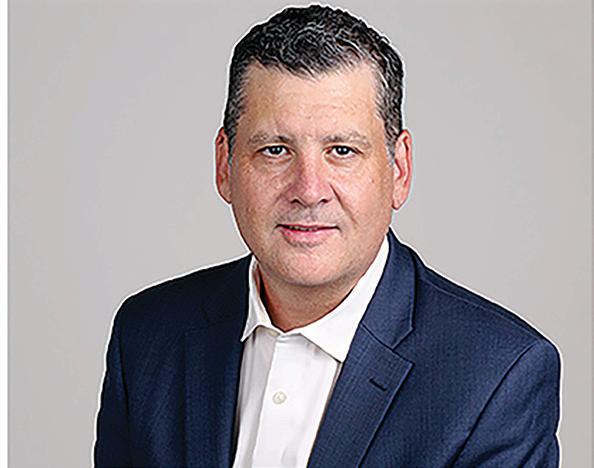
Mahoney explained that his top three priorities are using tax dollars more effectively, focusing
on community spaces and parks, and working with Peel Regional Police and Crime Stoppers to keep crime rates low.
Rahul Mehta
Rahul Mehta decided to run for councillor “to bring a change.”
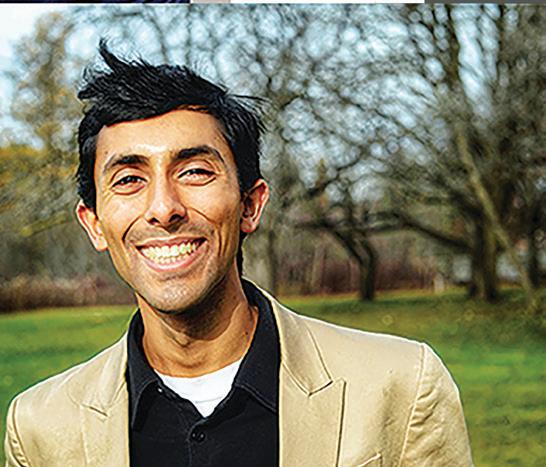
Mehta explained in an email to The Varsity that he has lived in Ward 8 for his entire life. As a UTM alum, Mehta plans to be “a tireless advocate” to better students’ experiences when it comes to university tuition fees and course and program availability. He hopes to get the council to ap prove clear policies to protect renters and ensure that secondary housing units — a term that, according to the City of Mississauga, refers to self-contained living spaces such as basement apartments — are clean and safe.
When it comes to transit, Mehta believes that “UTM students are being ripped off and their needs completely ignored.” He hopes to “double” transit services, secure a GO transit discount for students who have a U-Pass, and “[create] free transfers to and from adjacent cities (where many students live and currently have to pay extra).”
Mehta wrote, “I would also work with campus administration to improve shuttle bus service and
UTM Campus Council welcomes local high school students to new program
Program to provide university gateway to Black students
Lexey Burns Deputy News Editor
On October 3, UTM’s Campus Council meeting, Mark Overton — dean of student affairs and assistant principal, student services — and Jessica Silver — director of student engagement — presented a program that allows Peel region’s high school students to take courses and workshops at UTM. VicePresident and Principal Alexandra Gillespie introduced some UTM-specific growth statistics of student and faculty numbers as well as building space.
High school students at UTM Overton and Silver presented the new program to financially and physically support self identifying Black, Black African, AfroCaribbean, or Latinx Black high school students who are considering post-secondary possibilities.
The program allows them to take high
school courses ENG3U or ENG4U as transferable university credits. After completing the courses, the students are awarded a voucher to help pay for their Ontario university application. Currently, the average application fees for Ontario Universities’ Application Centre is $156. Applying to more than three programs, despite whetherif the programs are all at the same institution, costs an additional $50 per program. Some specific programs, including U of T’s Architecture, Commerce, Computer Science, and Engineering, require extra individual fees that range from $40–50 as supplemental program fees.
For the program, UTM has selected 12 students each from Meadowvale Secondary School and Fletcher Meadow Secondary School in the Peel region. Students for the program were chosen based on a select criteria: they must have been the permanent residents or citizens of Canada, enrolled as full-time students at either high school, and had a course average of 70 per cent to qualify.
“We hope that they come [to UTM], [but] regardless of where they go, we hope that that point five credit will be transferable, setting them already a credit ahead of their colleagues when they come into postsecondary,” Silver said during the meeting.
They also hope to offer students scholarships if they choose to pursue STEM programs.
UTM growth
In her presentation, Gillespie focused on specific areas of growth in comparison to previous years.
Gillespie began by noting some “major dates for our campus’ identity.” In 2003, UTM separated from the Faculty of Arts & Science as an independent division; in 2016, UTM was in the process of developing itstheir first academic plan; and in 2021, UTM announced the creation of the first strategic framework. The first strategic framework expresses UTM’s main priorities and commitments that they hope will strengthen consensus and help guide
upgrade and expand the transit terminal facility, with more shelters, heated pavement in the win ter and digital signs, maps and announcements for ease of use.”
Mehta’s platform priorities are bringing more transparency and accountability to local govern ment. He also hopes to build more affordable housing and safer transit systems that take differ ent methods of transportation — including biking, public transport, and walking — into account.
Irfan Farooq
According to Irfan Farooq, he is running for Ward 8 councillor “to serve and be an advocate on behalf of community.” Farooq, who works as a paralegal, previously received the Civic Award of Recognition from Mayor Bonnie Crombie.
As a candidate for councillor, Farooq is pri marily focused on reducing property taxes and building community, according to his Facebook page. Farooq pledged to increase police pres ence, in the hopes of decreasing carjackings and improving community safety. He also pledged to improve access to public transportation, as well as to repair roads.
Farooq did not respond to The Varsity’s request for comment.
larger investments.
She explained that from 2003 to 2021, the number of full-time students increased by approximately 151 per cent, from 5,779 to 14,514. In addition, the tenured faculty or faculty on track for tenure increased from 153 to 386 and full-time non academic staff went from 80 to 189. Finally, building space increased from 108,009 square metres in 2003, to 219,109 by 2021, a 103 per cent increase.
Gillespie then introduced the priorities of UTM’s strategic framework. She explained that “UTM is still going to grow this year… but it’s going to grow at a slower pace… We can make a positive impact by doing better, not just by getting bigger.”
Gillespie also said that UTM is prioritizing the environment in their framework, with the aim to “foster sustainability and embrace our place to model here the positive environmental impact that UTM researchers create in the world.”
“[UTM] will soon welcome a new national leading researcher to study an endangered species of Jefferson salamander and to develop strategies for its own campus conservation,” Gillespie elaborated.
The next UTM Campus Council meeting will be held on November 16.
Toronto’s former mayors oppose new strong-mayor system
Tony Xun Associate News Editor
On October 11, U of T’s School of Cities partnered with CBC Toronto to host several of Toronto’s former mayors in a discussion regarding Premier Doug Ford’s new strongmayor system. Adam Vaughan, a former MP for Spadina—Fort York and a Canadian Urban Leader with the School of Cities, hosted the event at Innis Town Hall.
Former mayors David Crombie, Barbara Hall, and John Sewall were in attendance; fellow former mayors Art Eggleton and David Miller joined them via Zoom. All five living former mayors of Toronto sat down to share their perspectives and experiences from their collective decades of governing Toronto.
Bill 3 — the Strong Mayors, Building Homes Act — received royal assent in September and Ford’s strong-mayor system will come into effect on November 15. This system grants a host of new powers to the mayors of Toronto
and Ottawa because it centralizes power within municipal governments.
The strong-mayor system
The bill allows mayors to circumvent their city councils with a veto and bypass majority opposition. In turn, a two-thirds majority of the council can still strike down a mayoral veto. However, the mayor’s veto is limited specifically to the interests of the provincial government.
Ford’s legislation also allows a “strong mayor” to appoint most municipal department heads, with notable exceptions including the city’s auditor general, police chief, and medical officer of health. Additionally, mayors are granted responsibility for preparing the city’s budget and are empowered to select committee chairs.
According to Ford’s provincial government, the strong-mayor system helps accelerate housing development by promoting efficiency and decisiveness in local government. The ability to bypass city council is intended to cut
through bureaucracy and foster development.
Toronto’s incumbent mayor, John Tory, has supported the expanded powers, saying that he welcomed measures to speed up the process of building more homes.
Concerns with the new legislation

Since it was announced in July, the strongmayor legislation has drawn controversy.
At Innis Town Hall, Toronto’s former mayors unanimously expressed strong opposition to the bill. “The legislation now passed is both unnecessary and a threat to local democracy,” Eggleton remarked. Miller agreed, saying that “no mayor of Toronto worth his salt would accept or advocate for the powers that the province has just given them.”
To Miller, the strong-mayor system represents a provincial attack on local democracy: “Why should the province tell the people of Toronto what they want in their city and how to build it?”
Importance of student engagement
Vaughan said that while U of T students have been quick to advocate for rights at the global and national level, “they need to be just as engaged locally because their lives are actually directly more impacted.”
He warned that the municipal election has direct consequences for U of T students, saying, “a weak City Council produces a weak transit system and a weak housing system.”
Vaughan called for students to make themselves heard: “Some of the best decisions in our city have been made when students’ voices have stood up and called for change.”
He reminded students to vote in the upcoming municipal election scheduled on October 24: “If you don’t vote, someone else will. And that’s the quickest way to lose your voice in our democracy.”
Toronto’s municipal election is on Monday, October 24. Voting runs from 10:00 am to 8:00 pm.
news@thevarsity.ca6 THE VARSITY NEWS
From left to right: Matt Mahoney and Rahul Mehta.
COURTESY OF MATT MAHONEY AND RAHUL MEHTA
John Tory’s predecessors denounce Ford’s municipal government reforms
Candidate profiles for Scarborough—Rouge Park


Choices for UTSC’s councillor
Alana Boisvert Associate News Editor
As the October 24 municipal election ap proaches, The Varsity profiled the three can didates who are running for city councillor in Toronto’s Ward 25 Scarborough—Rouge Park municipality, the electoral district where the UTSC campus is located.
Ashan Fernando
Ashan Fernando has been a resident of the Scarborough—Rouge Park ward for more than 22 years. He graduated from George Brown College with a diploma in hotel management. In an interview with Toronto.com he said, “I am not for the super-rich developers, nor a yes man to politicians or developers.”
One of Fernando’s top priorities is to provide dedicated housing spaces for the elderly, which he believes will allow elderly residents to build new friendships and have decreased feelings of
isolation. In an email to The Varsity, Fernando wrote that these dedicated housing spaces will also allow the elderly to rent out their previous residences, which will in turn provide “a well maintained property for students as well as oth ers who are looking for affordable housing.”
Jacinta Kanakaratnam
Jacinta Kanakaratnam moved to Scarborough with her parents in 1979. Currently, however, she lives outside Ward 25.
According to her campaign website, Kana karatnam has long advocated for affordable housing, community safety, and civic action in Scarborough. She also holds a Bachelor of Ap plied Science degree in justice studies from the University of Guelph and a diploma in law and security administration from Humber College.
Kanakaratnam currently works as a procure ment advisor, who advises companies on their hiring strategies, and is a director on the board of the West Scarborough Legal Services Clinic.
If elected, Kanakaratnam’s main priorities will be community engagement, mobility, and afford able housing.
Jennifer McKelvie
Jennifer McKelvie is the incumbent councillor of Ward 25. She has lived in the Scarborough— Rouge Park district since 2005 and graduated from UTSC with a Bachelor of Science in en vironmental science. She also holds a PhD in geology and, prior to being elected, worked as a professional geologist.

McKelvie sat on the UTSC Campus Council from 2015–2018. In her tenure as the chair of the Infrastructure and Environment Committee, she was able to secure funds to clean up litter,
repair recreational trails, and remove invasive species. McKelvie also made progress on some transportation projects, including plans to ex tend the Eglinton East LRT to Malvern.
Eligible students can use the City of Toronto’s MyVote web application to find their wards, learn where to vote, and access voters’ list in formation, among others.
While advance voting ran from October 7–14, voters in the ward can still go to one of 47 loca tions — including one at the UTSC campus — to cast their ballots on election day.
Jacinta Kanakaratnam and Jennifer McKelvie did not respond to The Varsity’s requests for comment.
SCSU’s failure to publish board reports concerns former directors
Board reports reveal that SCSU executives were elected to CFS–Ontario positions
Alyanna Denise Chua UTSC Bureau Chief
Although the Scarborough Campus Students’ Union (SCSU) has been holding its monthly board meetings, it has not been posting its board meeting packages on its website. As of October 14, the last time the SCSU published a board meeting package online was in June.
The Varsity was only able to acquire the July, August, and September board meeting packag es after repeated requests to the SCSU in Sep tember and October. These meeting packages reveal that on July 27, August 24, and Septem ber 26, the SCSU met with board members to discuss the election of some SCSU executives to executive positions at the Canadian Federa tion of Students–Ontario (CFS–O), as well as funding for grants, orientation events, and ad vocacy plans for the year, among other subjects.
Former SCSU directors wrote that, in light of the union’s failure to regularly publish these reports to the public, students should be con cerned about the SCSU’s transparency. In an email to The Varsity, SCSU President Michael Sobowale wrote that the SCSU recognizes the absence of these reports online and is now working to improve students’ access to board meeting packages.
Executive reports
The Varsity has not been able to cover any SCSU board meetings this academic year because the information had not been made public. The Var
sity has now obtained SCSU’s board packages from the last few months, within which we have found several updates pertaining to the UTSC student body.
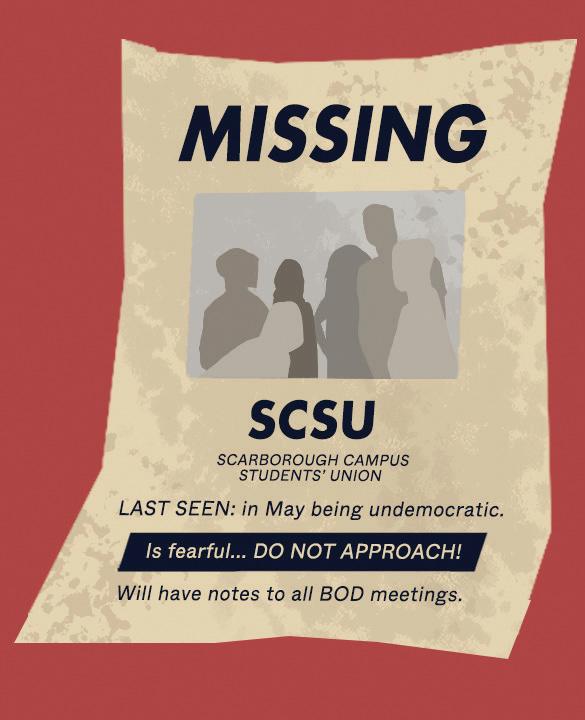
In the August board meeting, SCSU execu tives reported that they had attended the CFS–O’s Ontario General Meeting (OGM) virtually from August 15–18. Vice-President External Thai Dil lon Higashihara and Vice-President Academics Amrith David wrote that the OGM “was a space to bring forth local issues of our campus to [an] Ontario wide space in order to learn from other student unions.”
Higashihara reported that, at the OGM, he put forward a transit motion that the CFS–O ultimately adopted into the federation’s lobby campaigns for 2022–2023. Meanwhile, David passed a motion to create an “academic integ rity case resource hub” that would allow CFS–O representatives to refer back to previous cases of academic misconduct.
At the OGM, Higashihara was also elected as the CFS–O’s constituency commissioner, while David was elected as the CFS–O’s treasurer.
In terms of grants, Sobowale reported that UTSC’s Department and Alumni Relations Office committed $10,000 to the SCSU’s Food Cen tre. Additionally, UTSC’s Office of Student Ex perience and Wellbeing said it would commit to continue its support for the SCSU’s emergency grant as well as supporting the creation of survi vor and transit grants.
In terms of events, the SCSU hosted Frosh 2022: Revival from August 30 to September 1. In the September board meeting package, So bowale wrote that the event saw “a massive turn out.” The SCSU — along with the University of Toronto Mississauga Students’ Union (UTMSU) and RadioFWD — also hosted an “East Meets West” concert at Rebel Nightclub on September 8 that drew over 1,500 attendees, according to Vice-President Campus Life Alyssia Fernandes’ report at the September board meeting. The “East Meets West” concert served to connect students from the eastern and western cam puses of U of T.
In terms of advocacy, Higashihara reported that he — along with some full-time SCSU staff — met with Scarborough North’s Councillor Cynthia Lai’s team and Scarborough—Rouge Park’s Councillor Jennifer McKelvie to hear their campaign points for the October 24 municipal elections and to lobby for student issues. Hi gashihara also participated in a tri-campus roundtable to discuss mobilizing U of T students
to vote in the upcoming municipal elections.
Additionally, the SCSU is in the midst of lob bying UTSC deans for the implementation of the course retake policy and the credit/no credit policy, both of which are at different draft stag es. In September, Vice-Principal, Academic and Dean William Gough said that the UTSC admin istration is reviewing its course retake policy in order to “align [it] with changes that had taken place” at the Faculty of Arts and Science (FAS) and UTM. According to David, the SCSU will continue to lobby for both policies until they are implemented.
Lastly, Vice-President Operations Mat hooshan Manoharan reported that the SCSU — alongside JAB Management, a Toronto-based management and consulting company that specializes in hospitality operations — finally opened 1265 Bistro in September. 1265 Bistro replaces Rex’s Den as the SCSU’s own restau rant, and has a survey open to solicit feedback.
Former SCSU directors question the union’s transparency
The SCSU’s board is tasked with overseeing the services and advocacy activities of the SCSU, ensuring that the SCSU is operating in line with its policies and mandates. Board members for mally discuss the union’s activities with SCSU executives during monthly board meetings.
In the 2021–2022 academic year, the SC SU’s board meetings saw the executives raise their society and student centre fees by 5.2 per cent, their CFS fees by 4.8 per cent, their health fees by four per cent and dental fees by 10 per cent, and appoint new executives and directors.
Board meeting packages, meanwhile, con tain the agenda of the board meeting, execu tive reports, and committee meetings, among other documents, all of which will be discussed in each board meeting. According to the SC SU’s operational policy for board meetings, the union is required to distribute these packages to board members no less than 96 hours be fore each board meeting.
The same policy does not require the SCSU to give general students access to these board meeting packages or board meetings. Howev er, some former SCSU directors point out that publicizing these meetings is meant to be a part of a larger system of checks and balances on the SCSU.
“General students at UTSC only have the board packages to go off of for understanding
what the SCSU is doing with our fees,” Maxwell Fine — 2021–2022 SCSU director of physical and Environmental Sciences — wrote in an email to The Varsity. He added that one of the main ways that students can gain access to the SCSU’s board meetings is through the SCSU’s website.
Publicizing these meetings is also what the SCSU has done in the past. Both Fine and An astasiya Gordiychuk — an SCSU arts, culture, and media director from 2021 — pointed out that the SCSU livestreamed their board meet ings on Facebook last year. However, they have stopped livestreaming their board meetings since May.
In an email to The Varsity, Sobowale wrote that board meetings will now take place in per son at the Student Centre (SL-232). “The SCSU previously live-streamed board meetings to ac commodate virtual needs in the pandemic. Un fortunately, live-streaming sometimes caused an inhibition of participation due to discomfort of being recorded.”
Sobowale also explained the absence of the SCSU’s board meeting packages online: “We recognize the recent inconsistency with our promotion of Board packages and meeting dates. We are working to rectify the situation and will ensure improved notice to our mem bership through our instagram platform and Board of Directors tab on our website.”
Still, Gordiychuk emphasizes the importance of the SCSU making their reports public and accessible to students. “When the union stops publicizing board packages with all reports and financial statements, it creates a lack of trans parency, which, in turn, increases the chanc es for undemocratic practices and misuse of funds,” she wrote in an email to The Varsity
Gordiychuk advises students to hold the SCSU accountable, especially since each fulltime student at UTSC, as of this year, pays a mandatory fee of up to $499.93 per term to the SCSU.
While the University of Toronto Students’ Union and the UTMSU also do not have their latest board meeting packages on their respec tive websites, both unions regularly communi cate with The Varsity. In turn, The Varsity is able to inform the UTSU’s and UTMSU’s constitu ents of the unions’ activities.
thevarsity.ca/section/news OCTOBER 17, 2022 7
The Varsity broke down the profiles of all three UTSC councillor candidates.
COURTESY OF SRPRESIDENT VIA WIKIMEDIA COMMONS.
Anastasiya Gordiychuk was an Associate Busi ness & Labour Editor for Volume 141 of The Varsity.
ARTHUR HAMDANI/THEVARSITY
Mahsa Amini’s death further fuelled the global struggle for women’s rights
Around the world, women do not have bodily autonomy
Hiba Faisal Varsity Contributor
Content warning: this article contains descriptions of misogyny and violence, including honour killings.
Mahsa Amini’s death has sparked outrage around the world. In acts of defiance, Iranians have been marching through the streets demanding justice from the Iranian government and speaking out against the increasingly violent harassment perpetrated by the morality police.
Amini was 22 years old when she was arrested by the morality police in the streets of Tehran.
Originally from Saqqez, Iran, Amini was visiting Tehran when, on September 13 2022, she was accused by the morality police of disobeying Iran’s strict dress codes by improperly wearing her headscarf. This prompted the morality police to respond in an aggressive, violent manner that resulted in Amini’s hospitalization.
Amini was pronounced dead three days later, and according to Iran’s coroner, her death was due to a cardiac arrest. However, reports have surfaced containing CT scans that have proven that Amini suffered from severe injuries as a result of the morality police. These injuries included a fractured skull, damaged spleen, and internal bleeding.
As a Muslim woman, I feel a personal attachment to this story. The existence of a ‘morality police’ is demeaning and discriminatory against women. It is also an insult to the hijab itself.
The hijab is an extremely significant garment that is worn by Muslim women around the world. Women who choose to wear the hijab do so for reasons relating to their own faith and modesty. It is not meant to be worn as a garment for the government; rather, it is meant to signify one’s faith and devotion to God.
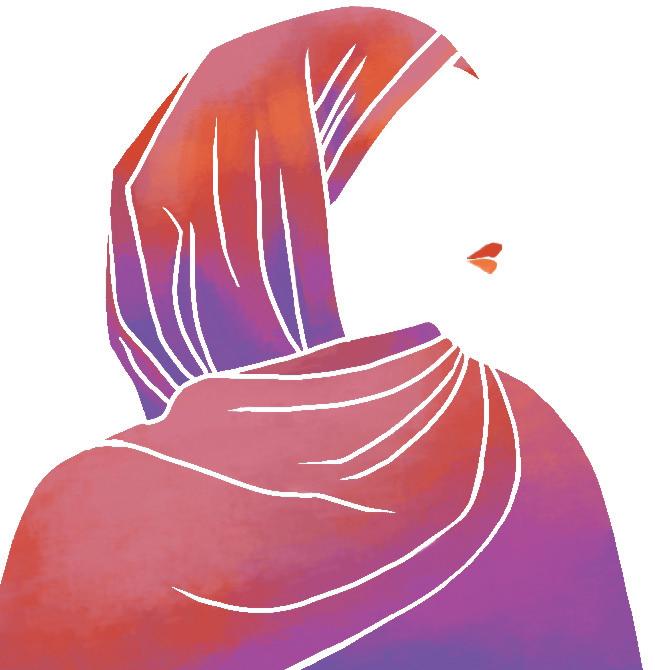
Forcing women to wear the hijab takes away so much of its meaning. To many women, the hijab is liberating, powerful, and a part of their religious identity. It is not something to be punished for or beaten to death over. The ex istence of the morality police is part of a con voluted system in which modesty is weapon ized against women under the guise of Islamic values — when in fact, the entire notion of a morality police is to humiliate women and force them into assimilation through violence.
However, the reality is that the concept of a morality police is a lot more common than we may think. Stories like Amini’s exist all around the world. For instance, in some places, wom en who are accused of immodest behavior are subjected to what are known as ‘honour kill ings.’
Honour killings describe the murder of a woman or girl by male family members. These men justify the killing by claiming that the victim engaged in sexually immoral actions and thus brought dishonour to her family. These “immoral” actions range from simply conversing with men to extramarital sex — even if that extramarital sex was rape or sexual assault. These killings occur frequently in India, Pakistan,
and the Middle East, yet are suspected of being underreported. One such case was the murder of Qandeel Baloch, a social media star from Pakistan. In a so-called honour killing, Baloch’s brother murdered for her supposedly dishourable behaviour on social media. It’s a sinister thought that some believe a dead woman is “better” than an immodest one.
On the other hand, women also face violence for choosing to dress modestly. In North America, there have been several accounts of women who have had their hijab ripped off their heads by strangers. In some instances, the strangers also hurl racist and Islamaphobic slurs at women and girls wearing a hijab. Various countries have also taken legal measures to prevent women from wearing the headscarf and dressing too modestly. In 2021, the French Senate passed an amendment that banned girls under the age of 18 from wearing a hijab in public.
In both cases, one thing is clear: women’s bodily autonomy is continuously being threatened.
In Iran, the government’s dress code restrictions on women is just another example of the lack of bodily autonomy women have. Women not having a choice, women not being able
to wear what they want, and women being labeled and judged for garment choices are all very familiar issues that we’ve seen across the globe. It all comes down to one simple concept: choice.
Therefore, the struggle for women’s rights in Iran is a global fight. As courageous Iranian women continue to fight on the front lines, we as an international community need to make sure their voices are being heard. Amini deserves to have her story shared until she receives justice.
Hiba Faisal is a fourth-year student at University College double majoring in English and political science and minoring in history.
Op-ed: How the municipal election affects student commuters Your vote in the 2022 municipal elections can help determine how transit issues are addressed
David Cho, Ryan Wong Varsity Contributors
As student commuters, we are all too familiar with the woes we encounter daily while taking transit. Whether we’re in the 416 or 905, on a streetcar or a GO train, it’s plainly visible to us that the systems on which we travel are at their breaking points.
On October 24, Ontario’s cities will vote for councillors, mayor, and school trustees. It’s im portant you cast your vote because it may help determine how some of the key transit issues that we are facing will be addressed in the next electoral term.
What are some major transit issues?
There are many issues with commuting by transit in the GTA. One in particular that most of us can relate to is the common phenom enon of bunching. Bunching occurs when two streetcars or buses travelling along the same route at the same time become packed to gether. While some people may take their frus trations out on the driver, the root problems causing this go much deeper. Transit vehicles carrying dozens of people can get stuck be hind cars with just one or two passengers in them, and lose precious time while a few cars turn at traffic lights. As such, measures such as transit priority and bus lanes are imperative to solving these systematic issues. Although the City Council planned to implement measures to address these issues, in the five-year Ser vice Plan and 10-year Outlook they released in 2019, the measures appear to be delayed.
Another issue that most GTA commuters ex perience often is unexpected delays. I’m sure my fellow commuters are familiar with having their train stop suddenly in a tunnel after a muf fled announcement over the intercom about a route delay.
While it is unfair to blame service changes entirely on the Toronto Transit Commission (TTC), it is fair to ask why communication re garding delays is not coordinated better. After all, how can people rely on busy streetcars and subways if their service patterns are never clear? Poor communication only drives riders away from transit and towards driving. This fur ther overcrowds roads, which affects bus and streetcar reliability. Ultimately, this creates a vi cious cycle for all residents of the GTA.
How are transit issues affecting students? With the rising cost of living in the GTA, cashstrapped students are finding it increasingly dif ficult to afford basics such as food, housing, and reliable transportation.

The current post-secondary monthly TTC
pass is not affordable for students, costing $128.15 per month. Even more absurd, though, is the fact that students must pay a full TTC fare simply to travel a few kilometers from the near est GO station to campus. Embarrassingly, the 905 — Eglinton East Express, which has far less transit patronage than downtown transit, has implemented free GO transfers.
However, the far larger TTC has yet to im plement free transfers because it needs more funding to provide these accessibility-improving initiatives. For city commuters to finally reap the benefits that their brethren in the suburbs have enjoyed for so long, the TTC must be further subsidized to recover from its budget shortfall and attract more riders with lower fares.
The transit situation isn’t any better for UTSC students, who are often relegated to over
crowded buses which seem to have a mind of their own. Once Line 3 Scarborough is closed as planned, UTSC students will have to ride replacement buses between Kennedy and Scarborough Centre stations for at least seven years.
Back on campus, current plans for an Eglin ton East LRT connecting Kennedy Station and UTSC are also unfunded. Additionally, with the TTC facing major budget shortfalls next year, the buses we currently rely on to get around Scarborough could see further service cut backs if City Council doesn’t improve funding for TTC.
How can students get involved?
While the road to a better commute will be dif ficult, politicians must act quickly to improve our transit and ensure that it does not continue to deteriorate while our population increases rapidly. If you are a regular transit user or sim ply care about transit issues, please do your due research and vote for candidates that will champion cost-effective, proven measures to improve transit reliability and accessibility.
No matter the outcome of the election, there are still ways you can get involved in fixing these issues. You can visit TTCriders.ca/2022 to see how Toronto candidates responded to our transit issues survey. Furthermore, you can ask our elected leaders to support the change that is needed for our cities to become more livable by signing our petitions at TTCriders.ca/ takeaction, or by signing up to volunteer from home or at one of our events across Toronto at TTCriders.ca/volunteer. We must all remember that this long and difficult road starts with the voices of many.
David Cho is a third-year student studying im munology and cell & molecular biology, and volunteers with TTCriders. Ryan Wong is a second-year student at UTSC studying city studies, and volunteers with TTCriders.
Comment October 17, 2022 thevarsity.ca/section/comment comment@thevarsity.ca
The Toronto transit system is at its breaking point. JULIA DEDDA/THEVARSITY
Democracy is crumbling, and women’s rights along with it Exploring democracy’s failures and their impact on women’s rights
Paden Neundorf Varsity Contributor
On September 28, I had the opportunity to at tend the U of T event in which Margaret At wood, renowned Canadian poet and novelist, discussed the future of democracy alongside other panelists. Atwood’s penning of a num ber of dystopian novels like The Handmaid’s Tale and Oryx and Crake gives her a certain level of credibility on the subject. Truth be told, I found the conversation to be interesting as it stirred up my own opinion on democracy and how it relates to women’s rights.
Democracy, a political system present in 96 out of the 167 countries with populations of at least 500,000, constitutionally promises the enforcement of legislation that defends the rights and interests of its citizens. Essentially, democracy assures that the people are given power, by proxy of elected officials, to partici pate in decision-making.
But the reality is that not everyone is repre sented equally in democratic decision-making processes. What specific demographics are actually being allowed to participate in deci sion-making?
In most cases, the answer isn’t women. The harsh reality is that women are underrep resented in these so-called equal decisionmaking processes. Despite constituting half of the world’s population, there continues to be a lack of representation of women as vot ers, elected officials, party leaders, and gov ernment representatives. As a direct result of this, women are being deprived of power, au tonomy, and agency.
When the US Supreme Court overturned Roe v Wade over the summer, female bodily autonomy and reproductive rights were cru elly violated. It’s no surprise, then, that just over a quarter of all seats in the current U.S Congress are held by women. If more seats were held by women, then maybe the state
of reproductive rights in the US would be dif ferent.
So the question is, why are women not be ing represented? The way I see it is that cis gender men in positions of power ignore the issue of women’s rights and want to continue to perpetuate systemic institutions of patriar chal oppression. Placing women in positions of power threatens these men because it would force them to be held accountable for their ignorance, shortcomings, and inadequa cies.
This heavily contributes to why democratic
societies are disintegrating worldwide. The equal representation promised by democracy should allow women’s rights to be enforced in political, civil, economic, and social contexts. However, this isn’t the case; women’s voices are not being heard and their rights aren’t be ing defended. How do we fix this?
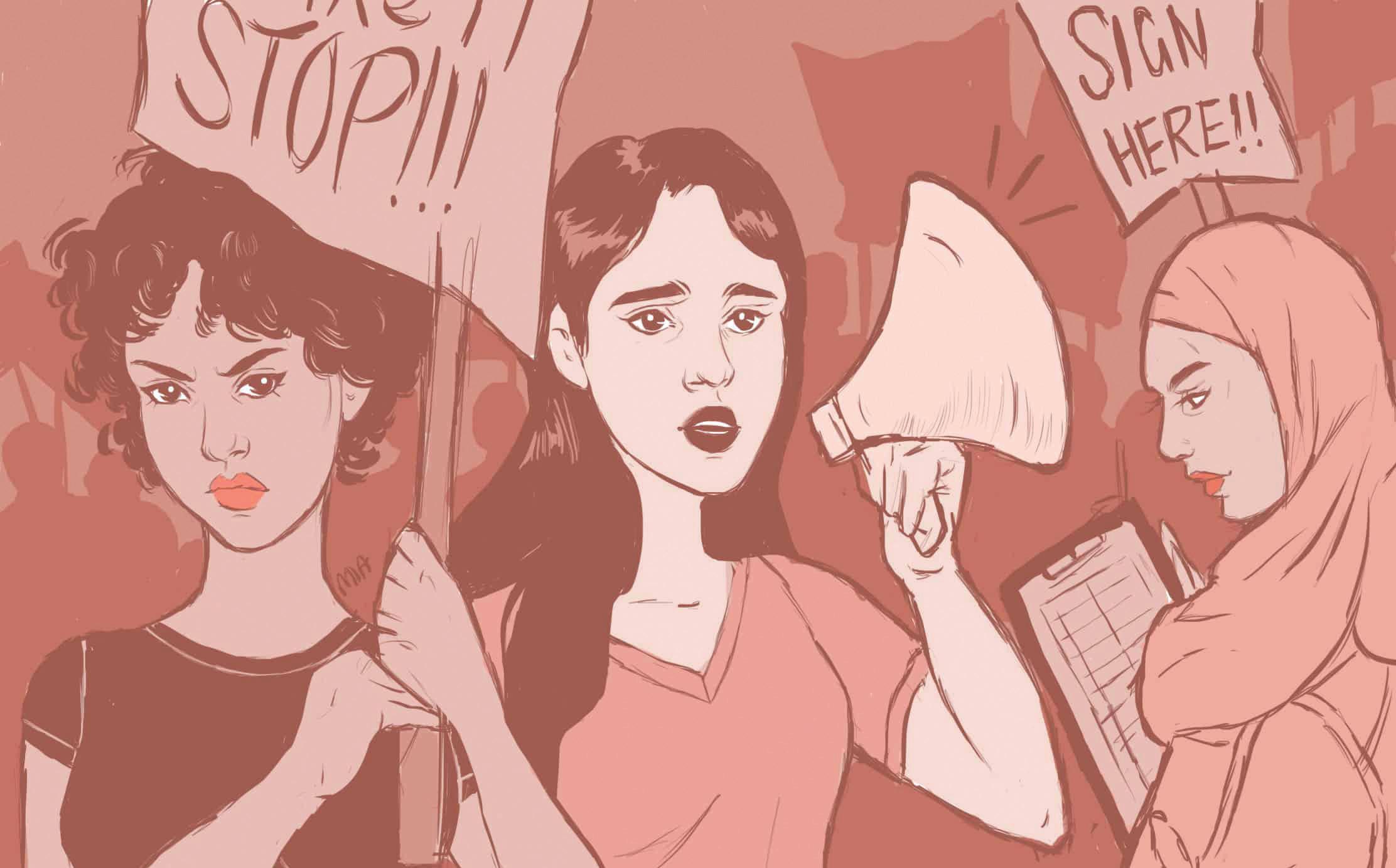
Atwood said at the event that “there is no straight line to democracy.” To ensure that democracy does not fall entirely, the slow pro cess of achieving the restoration of democ racy and, by extension, the rights of women, is anything but linear. So we get it, democracy is failing and women’s rights are not being represented equally in the decision-making process. But instead of lamenting over the state of democracy, we should turn to what must be done to ensure the women’s voices are heard to the fullest extent.
Democratic countries must reevaluate their political systems and the diversity of elect ed officials. They must ensure that there is
equal representation of men and women in their governing councils, so that legislation protects women’s rights. This would provide women with more opportunities to enter tra ditionally male-dominated spaces and finally have their voices heard.
In a special opinion piece for the Globe and Mail , Atwood wrote that “a war among wom en, as opposed to a war on women, is always pleasing to those who do not wish women well.” Atwood couldn’t have stated it better.
I believe it is the responsibility of men to dis mantle the toxicity with which they conduct themselves, challenge one another to respect women, and to adopt attitudes of respect and dignity toward them. Once women are seen as people under the eyes of the law and the men who implement its legislations, only then can we begin to see democracy’s restoration.
Paden Neundorf is a fourth-year English and equity studies student at Woodsworth College
better with processing study permit applications
their study permits processed in time to begin their studies during the fall 2022 semester. In an article for the Toronto Star, a spokesperson from U of T reported that as of September, more than 600 permits for U of T students were still outstanding.
While IRCC has been working on reducing the backlog of applications in their inventory, the cur rent process and excessive backlog still places in ternational students in a sticky situation.
The transition back to in-person after online learning only gives international students a certain window to enter the country before classes and assessments begin. If international students aren’t able to enter the country past this timeframe, they have no choice but to postpone their semester. I know this experience pretty well myself.
When I graduated high school, I was counting down the days for my student visa to arrive so that I could begin my new journey at the University of Toronto. Just like all other students, my excitement overcame me and I planned even the tiniest of de tails.
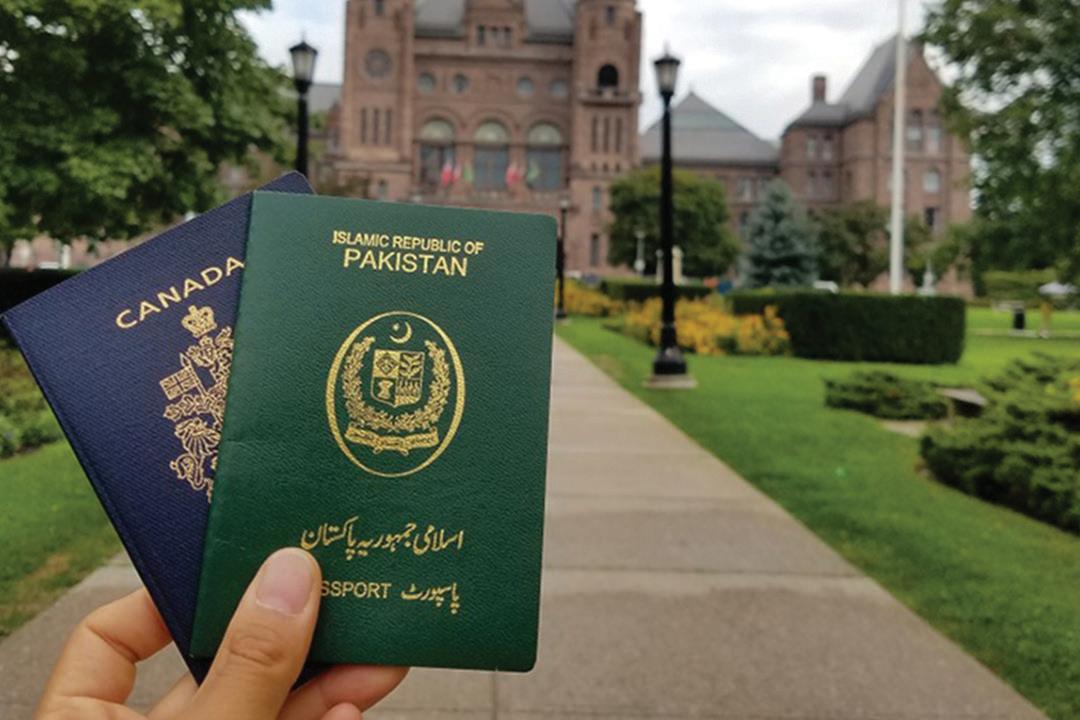
postpone my semester. I ended up having to take a gap year that I had not planned for. Despite my situation, I was able to find a way to continue my studies.
The unpredictability of the situation can create a lot of instability for international students, as it can be a really emotional time period with very limited options. Additionally, many students who postpone their semester end up graduating a year later than they expected.
In the article for the Toronto Star, Leila Gho drat Jahromi, discussed her issues with obtain ing a Canadian study permit so that she could begin her master of education degree at Simon Fraser University (SFU). Ghodrat Jahromi, who was in Turkey at the time she was interviewed by the Toronto Star, sold land she received from her parents and her car to cover the cost of tuition. She received her acceptance from SFU in Febru ary and then applied for her study permit in early June. However, Ghodrat Jahromi was forced to postpone the beginning of her program to spring 2023 because she had not received her visa in time.
The government of Canada requires that most international students obtain a study permit and student visa before they enter the country and begin their studies. If there’s one thing most international students have in common, it's knowing the painfully long process of applying
for student visas and study permits. It’s not the application procedure itself that is long, but rather the waiting time to actually receive our student visa and study permit.
According to the Government of Canada, as of September 30, 2022 there are around 2.6 million applications in the inventories and a 31 per cent backlog of study permits in Immigration, Refugees and Citizenship Canada (IRCC). With this backlog, many international students would not have had
Yet, what I didn’t anticipate was not receiving my visa on time. September was fast-approach ing and my study permit application still hadn’t been processed. I was lucky the immigration ad visors at U of T and University College were doing everything they could to help me. Unfortunately though, my time was up.
When the semester began, it was clear I wasn’t going to get my visa in time despite everything U of T was doing to help me. I had no choice but to
Immigration, Refugees and Citizenship Canada (IRCC) needs to do better to address these back logs. Whether this means hiring more staff to pro cess applications, or establishing a better system for reviewing applications, something needs to be done. For international students, attending school abroad means not only investing a significant amount of time and money into their future, but also leaving family and friends behind. This pro cess takes a toll on students and the added stress of worrying about a student visa and study permit doesn’t help.
Hiba Faisal is a fourth-year student in University College double majoring in English and political science and minoring in history.
comment@thevarsity.ca8 THE VARSITY COMMENT
IRCC needs to do
Many international students aren’t receiving their study permits in time for the start of the school year
Hiba Faisal Varsity Contributor
MIA CARNEVALE/THEVARSITY
As of September, IRCC reported a 31 per cent backlog of study permits.
SANDY MATHE/THEVARSITY
Huda El Zein Varsity Staff
From the moment I was born, doctors apologized profusely to my parents about who I was not and who they could not hope for me to be.
After already welcoming three boys, my parents were ready for a daughter to join their family. I could have come out sporting a lizard tail and 12 heads — there was never much that could have dimmed my family’s excitement over finally welcoming a baby girl. Thankfully, in the absence of any reptilian vestiges, and in spite of those doctors’ patronizing worries about the quality of my future, I was healthy. To celebrate, my dad gifted me the name that he dreamt of 15 years prior — the Arabic name “ن ” that proclaimed me “the light of guidance” and is the origin of my current nickname, Huda.
This celebration ended within the week of my birth, when I was poked, prodded, scanned, weighed, and measured in the hospital. All the while, my anxious parents wished to take me home. Eventually, I was diagnosed with hemifacial microsomia (HFM), a condition in which the tissues on one side of my face are underdeveloped and do not grow normally. HFM is a manifestation of oculo-auriculovertebral spectrum disorder (OAV), a rare congenital birth defect that, in varying degrees, affects the craniofacial — head and face — bones, the eyes, the ears, and the spine.
Yes, I was born healthy. But I also happened to be born with improperly grown craniofacial structures on the left side of my face and head. This was all because of grade III microtia — a deformity of my outer ear, leaving a small remnant ear lobe — which is why doctors warned my parents when they greeted me into the world. Maybe these doctors were displeased because I had an improperly formed middle ear, no ear canal, and no outer ear. They could have been put off by the small, irregularly shaped bones that made up my left jaw, creating facial asymmetry. Perhaps they were outraged because I have congenital scoliosis, a curving of the spine, and renal dysplasia, a failing kidney, on one side. They estimated the quality of my life from what they saw outwardly: a human Toyota Prius hybrid.
My family seemed to be on an undeterred quest to prove the doctors wrong. The doctors warned that it would be likely that I would be held back in school, so I started reading by age two and took on math equations at age three. The doctors predicted that I would never excel in an artistic outlet that relied on hearing, so I played the piano and the violin, was in a handbell choir throughout elementary and junior high school, and have been a highland dancer since I was three years old.
I may not have been a child prodigy, but I was not what those doctors had reduced my future to. They had thrown me into a box that had labelled me as having a physical defect. Having a defect meant that I was defective. Being defective meant that I was wrong. Being wrong meant that I was a failure. Being a failure meant that I would never have a successful future.
I refused to be limited by the restraints of an ill-defined box. So I took away the dichotomy that seemed to dictate my life and focused on building my own sense of identity. My life was neither right nor wrong, neither good nor bad — I simply decided that it would be mine.
Not for fixing
There was no way to get to the root cause of why my body took shape the way that it did. There are no definitive causes, no defined genetic contributors or environmental exposures that are directly linked to HFM.
It’s suspected that my abnormalities

manifested around the first month of my mother’s pregnancy through an unknown process that disrupted the development of my first and second pharyngeal arches. Pharyngeal arches are early embryonic structures that dictate fetal development of cartilage, bone, muscles, glands, certain organs, and the major structures of the head and the neck. Though a child can be diagnosed with OAV syndromes at birth, there are some details that doctors will not know until those children grow older. At this point, doctors can better see structural abnormalities.
In my case, many of the varying manifestations of my HFM were undetectable without close observation — with the exception of The Ear. It was a glaringly obvious issue, but, truth be told, I really liked it. It was a small ball of remnant cartilage and a flap of skin that vaguely resembled a peanut. Moreover, it became a big part of my identity. I was “the girl with one ear” and that ear became a source of inside jokes

and made-up stories. It was my self identifier — as in, “Look out for The Ear,” or “We’ve always got to accommodate The Ear!”
My parents were hellbent on making sure I never felt out of place because of my differenc es. My appearance was never a taboo topic in my home, nor was I taught to shut down ques tions from curious preschool friends or their parents. I was put into dance classes early on; my hair would often be slicked back into a tight bun or ponytail and kept there at the mercy of a generous amount of hair gel. Still, I didn’t ever feel self-conscious about the exposed missing artefact from my head. I went to school boast ing elaborate, pinned-up hairstyles, oblivious as to whether or not The Ear showed.
Obviously, without a properly formed ear, there was no hearing. I am Deaf, and was also mute for much of my early childhood. Instead of speaking, I relied on sign language to communicate to my parents and my best friend.
Doctors regularly offered my family and me aids to assist my hearing. When I was five, we discussed the possibility of the Bone Anchored Hearing Aid (BAHA), a device externally fixated to the skull that would allow conduction for some hearing on my left side. The doctor gave me a temporary BAHA affixed to a tight metal headband. In an effort to make it appear less bleak to a kindergartener, my mum bought ribbon and small fake flowers to decorate it. I hated it. I don’t remember how much it did or didn’t work, but I hated it. It felt weird, and more importantly, I felt weird. While wearing it, I was self-conscious about my appearance and knew that, in some way, I was no longer myself. Although I was young, my parents allowed me a great deal of decision-making power when it came to my body. I vetoed the BAHA, and it was never brought up again. It is a deci sion I have upheld until this very day.
Later, in elementary school, I tried a frequency modulation (FM) device — a tool
10 THE VARSITY FEATURES
From the peanut gallery I came into the world with a birth defect, so I was perceived as defective from birth
Later, in elementary school, I tried a frequen cy modulation (FM) device — a tool used in conjunction with a normal hearing aid — which helped amplify sound in my good ear. Although it aided with my hearing, I felt embarrassed and scared every time I had to ask a substitute teacher, guest presenter, or other adults to use it, scared they would mock me in some way.
The truth is, I was happy being Deaf. Similar to The Ear, it was an integral part of my identity. Yes, being deaf in a hearing world that is unfit to cater to my needs means that I have a disability. Being deaf in itself, though, is a privilege.
To many, if not most, hearing people, being deaf is construed as something to be fixed. For me, however, being able to turn off one of my key senses and tune in to other sensory stimuli is a unique experience. When I could see people speak, but could not hear what they said, my imagination could run wild coming up with what they were talking about. Watching body language, facial expressions, and lip movement, I could construct the wildest of conversations in my head, and found it truly peculiar to be able to eavesdrop without hearing a thing. I think this is why I took so well to dance and music — music is about listening with your emotions, and dance is about feeling
the sound.
Cochlear implants in babies, BAHAs, and FM devices — rather than being seen as the aids they are — are touted as solutions to a problem, the problem being the deafness itself. Although I don’t use sign language in my dayto-day life anymore, Deaf culture and identity are still core components of who I am. A per son’s identity isn’t something that can be fixed.
A semblance of normal
Although I was resistant to procedures to restore my hearing, I had always entertained the idea of ear reconstruction. I’d maintained an obsession with human anatomy from as early as I can remember. The earliest age that I would be eligible for surgery was age 12, so I was happy to spend each year leading up to that considering such a fascinating concept. I was hooked on the idea that a piece of my body could be built from seemingly nothing.
The year I was born, I became a patient at the Institute for Reconstructive Sciences in Medicine, a world-renowned clinic and research institute based out of my native Edmonton’s Misericordia Hospital. There, I continually visited my plastic surgeon, who would evaluate me for surgery and discuss hearing options with my parents. Eventually, I was prepped for
the Nagata Method of Auricular Reconstruction (NMAR), which was considered to be a gold standard in reconstructive procedures in the HFM community.
NMAR uses the patient’s tissues for recon struction rather than prosthetic materials. This is ideal because there is no chance of rejec tion or of the ear needing to be replaced. The procedure consists of two separate surgeries, which is fewer than other methods of recon structive surgery.
In the first procedure, cartilage is harvested from the floating rib of the patient and carved into the shape of an ear. A pocket in the scalp is then made to host the real, fake ear. Stitches are placed to adhere the skin and cartilage, and wires are inserted to adhere the ear flush against the skull. In the second procedure, the leftover cartilage lifts the ear away from the head, giving the skin a more realistic look. It’s an artistic feat that can make even the most seasoned surgeon break a sweat.
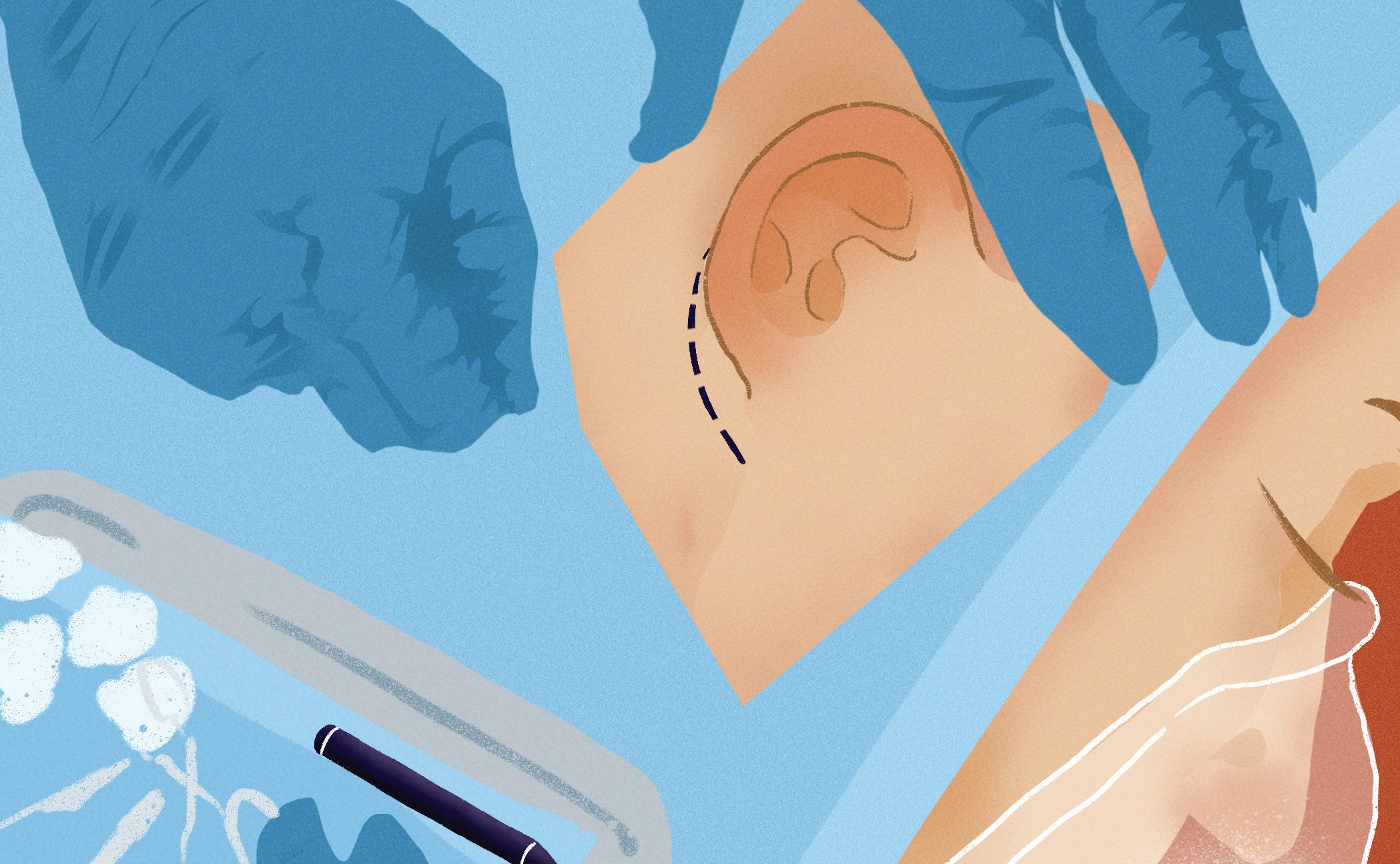
When I entered junior high, I was finally at the age where my surgeon was comfortable proceeding with this surgery. Similar to my openness about The Ear, I was open about my decision to have reconstructive surgery. When I finally received an appointment date — April 18, 2012 — I eagerly talked about my surgery
with my friends, as it seemed surreal that the moment I had spent my life preparing for had finally arrived. One conversation that I had was with my best friend, Karen, during our school’s lunch hour:
“So after the surgery, are you going to be able to hear?” Karen asked.
“No,” I replied.
“Then what does it do?”
“It gives me an ear,” I answered, hesitant as to what she was implying.
She accused me: “You’re having plastic sur gery.”
I scrunched up my nose, similar to how a child would if someone offered them a matterof-fact statement that they were reluctant to accept.
I offered an “I guess” under my breath and diverted my eyes downward.
Those words — “plastic surgery” — sound ed bad. They sounded ugly, conceited. To Karen, “plastic surgery” is all it boiled down to. And so I, a newly minted teenager, came to the realization for the first time that what I had spent 13 years preparing for was just “plastic surgery.” I felt discombobulated. The Ear was a big part of my identity, and now it would be changing. This surgery would split who I was in two: me before the surgery and me after the surgery.
That night, I felt vain and disappointed in my self. I stood in front of my bedroom mirror and traced my fingers over the space where my ear would soon be. I studied my body from head to toe and asked, what’s next? Where does it end? Did I want a nose job? Boob job? Butt lift? What outcome was I truly after?
I certainly wasn’t insecure about The Ear, so the only plausible answer that I could conjure up was “a semblance of normal.” But could I be secure about who I was and still pursue sur gery towards something else, something that I perceived as normal?
A guiding light
This past April, I celebrated the 10th anniver sary of receiving a new ear. While I can’t travel back in time to assure myself that I made the right decision, I can bring all my knowledge into my upcoming jaw surgery and enter it with a little more confidence than I once had.
For a while, I was hesitant to go forward with further surgeries. Plastic surgery represents an often inaccessible realm in health care that is associated with privileged socio-economic status, or someone who is vain. But plastic surgery is also for reconstructive procedures for patients with birth defects such as myself; it’s nose jobs to assist with breathing; it’s re constructing body parts after bodily trauma or cancer; it’s burn care; it’s cleft lip and cleft pal ate repairs; and it’s gender-affirming care. Most importantly, it’s an integral part of health care and plays a role in moving towards the United Nations’ Sustainable Development Goals — one of which aims to promote healthy lives and wellbeing for people of all ages.
This revelation reinstated the confidence that I had lost and reassured me that there was nothing wrong with going through with the procedure. The decision-making powers that my parents granted me growing up were not something commonly seen, particularly for children. So, when the opportunity came along to create change from sharing my story, I knew I wanted to take it.
I approached the team for the Craniofacial Microsomia Accelerating Research and Educa tion (CARE) study at Seattle Children’s Hospital in the spring. The study seeks to learn about the lived experiences of the CFM and HFM communities, their families, their health-care teams, researchers, patient advocacy groups, education systems, policy makers, and mem bers of the public. The hope is that, by learning more about CFM from varying perspectives, the overall wellbeing, access to care, and edu cational resources available to patients and their community will be greatly improved to best reflect their unique needs.
Perhaps, by assisting with this study, I can live up to my namesake. Perhaps, to someone somewhere, I can be a “light of guidance.”
features@thevarsity.ca
SEAVEY VAN WALSUM/THEVARSITY
Is it just me or is everything more expensive these days? Several factors are driving ongoing inflation
Georgia Kelly Associate Business & Labour Editor
No, it’s not just you: things are getting more ex pensive. The average price of goods in Canada rose seven per cent between August 2021 and 2022. Over the last 12 months, grocery prices have increased by 10.5 per cent, the highest rate in 40 years.
“A few months ago, I was buying some ap ples, and I think it came up to $2 per apple, which really shocked me,” recounts Rachel Lin, a third-year Rotman Commerce student, in an interview with The Varsity. Jakob Kramer, a thirdyear philosophy specialist, said, “I bought two days worth of dinner — so two meals’ worth of food — and it was $60.”
This overall rise in prices is called inflation. Slow and steady inflation is generally a good thing, even if costs are higher for consumers; it indicates that people are buying things, therefore businesses can make a profit and people can find jobs. Earlier in the pandemic, people had feared that no one would be spending any mon ey in the wake of lockdowns, causing prices to deflate, leaving people unemployed. Two years into the pandemic, we are seeing the opposite trend.
The culprits behind inflation

A fun cocktail of current events is jacking up the prices of Canadian goods. A ban on Russian crude oil, a shortage of Ukrainian cooking oil and wheat, and droughts in Canada’s farming regions are making food items more scarce. Meanwhile, everyone is itching to go out after 24 months of being forced to stay indoors. Essentially, people are consuming faster than suppliers can provide.
The Progressive Conservative (PC) party of Canada, meanwhile, has coined the rise in pric es “Justinflation,” placing the blame on Justin Trudeau government’s spending. At the begin ning of the pandemic, the Bank of Canada had provided people with a considerable monetary boost by lowering interest rates and purchas ing assets to help relieve the economic down turn that the lockdown had caused. However, increased government spending can disrupt the delicate balance between demand and supply, and thus drive up prices.
Another viable culprit is private corporations. Loblaws, the largest grocery store chain in Can ada, has grown its profits by over 40 per cent in the last year, and commentators are accus ing the company of hiking its prices excessively. These commentators argue in a Toronto Star re port that if price increases were proportional to rising inventory costs then profit margins should remain the same. Grocery giants Empire and Metro have also seen boosted profits in the last few months.
The consequences of inflation
Avoiding more expensive grocery items isn’t pos sible when essential items are all rising in price at the same time, said Charmaine Handojo in an in terview with The Varsity. “There’'s only so much you can cut.’ Handojo is a third-year student double majoring in ethics, society, and law; and bioethics.
According to Kramer, an alternative option is consuming less to keep costs down. Kramer re sorted to unhealthy habits in an attempt to cut his costs. “I eat less food… I almost passed out last week, ” he said.
Handojo shared her view on the pros and cons
of inflation: “It’s not a good thing or a bad thing, but when the prices go up and wages don’t, I think that is bad.” Indeed, average wages in Can ada are lagging behind as the price of essential goods increases. This means that students have less money to spend on non-essentials. Kramer said, “I’ve also had to turn down just about every social invite, because I can’t afford to go to res taurants.”
Working students must also put in more hours in order to cover their expenses. Samuel Dumas, a third-year mathematics major, works around 20 hours a week: “I can definitely look at points to wards the middle of the semester when I feel so wiped. I barely sleep.”
For some economists, the hope is that in creased prices will slow down consumer spend ing, helping to curb the price spike and making goods affordable again. Others are skeptical of such a mindset. Kramer describes it as “[letting] 10 per cent of people starve, and then [figuring] out how much food everyone [else] needs.”
What’s the solution?
In response to rising prices, the minimum wage in Ontario is increasing from $15.00 to $15.50 on Oc tober 1. It has increased over the last 12 months by about eight per cent, as last October, it was set to $14.35. At the same time, the Ford government is currently defending provincial legislation that caps wage increases at one per cent a year for public sector workers such as nurses and teachers.
Another possible response to inflation is to regu late the cost of essential goods like groceries so that people’s access to them is not dependent on private corporate decisions. Kramer urged his view that “there are systems in which you can organize an economy and create goods that don’t put the suffering and the loss of individual humans on the line.”
Inflation also increases house prices. “I hope the problem isn’t so severe, that by the time I come to the stage in my life where I hope to be a home owner and have to put down a mortgage, that the interest [rates] are so screwed up that it is unfea sible,” Dumas reflected.
Opinion: Automation is not a blessing, but it doesn’t have to be a curse either Automation is imminent, but humans must control the rate of its takeover
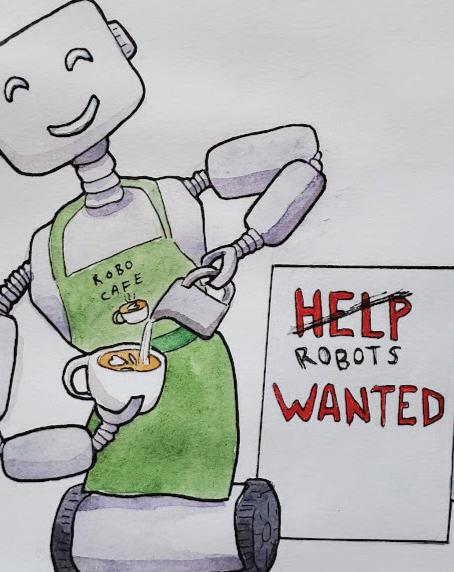 Zen Nguyen Labour Correspondent
Zen Nguyen Labour Correspondent
If there’s one thing that seems to move faster than time nowadays, it is the pace of scientific innovation. New technology threatens to change everything in our lives, especially what is required of human beings in the labour market, as artificial intelligence (AI) and automation take over businesses.
The power of automation is real
Automation is when machines work to reduce hu man intervention in tasks. However, the idea is not just to replace, but to outperform, human labour. Enthusiasts of self-driving cars and AI-powered medical diagnoses boast of the superiority of automation, and how it could be more efficient, accurate, cost-effective, and timely than if these tasks were carried out by human labour. Comput ers are already better than us at chess and Go, and can even play complex games like Dota 2 pretty well.
The benefits of automation are manyfold — if adopted, automation could promise higher pro ductivity and higher quality products and services, which would lead to economic growth and higher living standards, as we could produce more with less human effort.
Additionally, automation and machine learning may speed up further technological development when applied to research. For example, AI has been used to generate almost every protein struc ture possible.
Machines are replacing human creativity
Automation has changed the employment landscape several times throughout history. While many jobs, like those of word processors and switchboard operators, have disappeared due to technological innovations, many more have been created to service and create machines to satisfy new demands. As such, employment statistics have much more to do with the business cycle than waves of automation.
However, the argument goes that this time, automation will be different. While previous waves have replaced human manual labour, the next wave threatens to replace the mental and creative capacities previously thought to be unique to us. This ranges from the ability to receive and give language input and output, synthesize information, and much more.
Machines can write essays, compose songs, and generate digital art now. While workers on assembly lines were replaced with machines, those workers found new jobs operating machines. In the future, this monitoring — and even planning — can theoretically be automated, leaving humans redundant. Machines can potentially even replicate themselves: an AI can potentially be replicated by copying its own lines of code.
Thus, I believe that it is only a matter of time before most jobs become obsolete due to automation. When that time comes depends on how optimistic you are about the pace of technology. Given the massive scale of human labour redundancy, mass automation may eventually lead to large structural unemployment, which some economists have argued can potentially cause other issues like increased inequality and economic destabilization.
Job transformation versus job loss
A 2020 Statistics Canada study suggests that more than 10.6 per cent of Canadians’ jobs are at high risk of automation. It also shows, intuitively, that automation will affect people differently. Office support or manufacturing jobs are most at risk. Workers who are older, who work part-time, or who have lower income are all also at higher risk.
However, the strongest reason to scoff at the imminent mass unemployment scare is simple: studies conducted define the risk of automation purely by the possibility of automating a job. As the 2020 study wrote, “workers at higher risk may be more likely to experience job transformation, which may or may not involve job loss. The degree of job transformation will depend on the degree of adoption.” Adoption of new technologies in turn depends on how profitable it is to replace human labour with machines. For example, is it more profitable to replace cashiers with self-checkout booths?
The profitability of automation depends on many factors, such as the price of investing in different automating technology, the price of labour, and other constraints on businesses, perhaps from regulations or organized labour. These conditions are not set in stone, and we can determine them. The report published by Statistics Canada admits that, beyond technical feasibility, “it may be challenging to try to account for the actual probability that firms will adopt automation technology.”
It is best to liberate ourselves from the ‘technology versus employment’ dichotomy and realize that the future is up for grabs. The
adoption of automation is not an unstoppable force, and we can and should control the pace of it.
One must also consider whether mass unemployment can be a good thing — after all, if humans are no longer needed for most tasks, why shouldn’t we be freed from our jobs or work fewer hours and enjoy more leisure time, while still enjoying the higher living standards brought about by automation? Perhaps ideas like a universal basic income or a four-day work week are but dawning realizations that our economy must change to suit our productive capacity. Automation may work for us, but only if we seize the initiatives to decide what this technology will mean for our society.
Business & Labour October 17, 2022 thevarsity.ca/section/business biz@thevarsity.ca
CHRISTINA DINH/THEVARSITY
JACK REILLY/THEVARSITY
Arts
Culture
Toronto as a setting: Its past, present, and future in the film industry Why Toronto has become an “Imposter City” — and why we should break out!
Sanaa Mahmud Varsity Contributor
Toronto is known for many of its unique sights — the CN Tower, the Royal Ontario Museum, Casa Loma, and, of course, the University of Toronto. In movies such as The Incredible Hulk and RoboCop, Torontonians may spot city staples like these scat tered throughout, and are sure to continue spotting them as new blockbusters are filmed in the city.
Yet, the city itself often takes a backseat in the film industry, posing as other well-known, primarily American cities. Countless global film phenomena have been filmed in Toronto, but have disguised the city as other prominent locations. Guillermo del Toro shot The Shape of Water — the 2017 winner of the Academy Award for Best Picture — in To ronto, using UTSC, Massey Hall, and the Lakeview Restaurant as backdrops for various scenes. Yet, the film itself was set in 1962 Baltimore, Maryland.
The same is true of Good Will Hunting, an Acad emy Award winning film from 1997. Although the movie was set in Boston, Massachusetts, UTSG and the Central Technical School, a high school located on Bathurst Street, were used to fill in for Harvard University and MIT, respectively. Louis Leterrier’s 2008 film The Incredible Hulk was also primarily filmed in Toronto, using U of T spots such as Convocation Hall, King’s College, and Knox Col lege to emulate various New York City locations.
Toronto may be the ‘Hollywood of the North,’ but it’s hardly ever established as its own setting in popular media. Film lovers and city dwellers alike may wonder why this is, and if we will ever get to see Toronto playing itself in the future.
Money, money, money

In the past two decades, Toronto’s film and television production has risen to become one of the city’s major economic industries. In March 2022, Toronto Mayor John Tory announced that the city had invested $2.5 billion in film, television, and digital media productions over the previous year. The city saw 1,468 individual productions and
7,800 production day bookings in 2021. Toronto’s screen production industry is expected to undergo even more rapid growth in 2022.
One major reason that production and media companies choose to film in not only Toronto, but Canada in general, is the low filming costs. Other than the high exchange rate between the Ameri can and Canadian dollar, there are many financial benefits to making a movie in the Hollywood of the North.
The Canadian film industry offers significant tax incentives for film, television, and digital media.
Canada requires no entertainment taxes — and even offers stimuli — for hiring local actors and mu sicians. According to the federal government, vari ous tax credits can save filmmakers up to 45 per cent on qualified labour costs, as well as up to 35 per cent on total production costs.
Additionally, Canadian cities have a lower cost of living than American ones, so movie sets are much more affordable. Canada also offers a large and distinguished pool of talented individuals who are available at cheaper rates than in the United States, making production less costly.
From a creative standpoint, Toronto is a perfect filming location, as it experiences four distinctive seasons. Summer, spring, fall, and winter in the city are all very different; therefore, filmmakers have greater freedom when deciding the time period during which to film their piece.
There is also plenty of land available in Canada that offers the physical and natural beauties that are harder to access in the US. For example, in the blockbuster movie Pacific Rim, exterior scenes were shot in the Scarborough Bluffs and in the Port Lands near the waterfront. In the city itself, Toronto itself has several distinct neighbourhoods that, al though recognizable to locals, are both aesthetic and vague enough to stand in for various American cities.
An authentic future
More often than not, Toronto is merely a stand-in for other well-known locations around the world. This fact was recently both acknowledged and in vestigated in Imposter Cities, an exhibition in the 2021 Venice Architecture Biennale. Commissioned by the Canada Council for the Arts, the exhibition
explored how Canadian cities frequently portray other major cities and how this relates to architec ture and our national identity.
The purpose of this exhibition was to encourage thought about the way that architecture is experi enced in the digital age, how architectural identities are formed, and to convey the fact that our percep tion of the world is based on constructed realities.
As reported in The New York Times, the creators of the exhibition stated that the reasons for Canada’s “impostor” status in the film industry were a “friend liness and a general unfamiliarity with Canada among international movie audiences, allowing it to easily stand in without being recognized.”
In a 2019 article for Architect Magazine, critic Wi told Rybczynski commented on Canada’s soft and relatively unrecognizable architecture: “Canadian architects have generally toed the Modernist line, preferring to leave radical experimentation to oth ers.” The New York Times article adds that Cana dian architecture has received less global recogni tion, as it has been interpreted as “timid,” boosting the drive for filmmakers to use cities like Vancouver and Toronto as ‘impostors.’
In 2022, however, Toronto is continuing to devel op its own reputation as a setting in movies and TV shows. The city can be seen ‘playing itself’ in the Pixar hit Turning Red, for example. This Americanproduced movie showcases distinctive Toronto locations, such as the CN Tower and city skyline. As Toronto is one of the most diverse cities in the world, the film accurately portrays the city by telling the story of a Chinese-Canadian girl’s discovery of her family background.
As racial and gender representation progresses throughout the film industry, Toronto will surely be come the focus of more Hollywood projects. The city not only has a wide range of talent, but de mographically sets a leading example for diversity and inclusion that could be more frequently show cased. Let’s hope that in the coming years, Toron to’s charms become more widely recognizable in popular works, showing the world that it is the true Hollywood of the North.
The Howland Company brings Chekhov to campus
Hart House Theatre chips in on new production
Liam Donovan Varsity Contributor
In the living room of a house on Howland Avenue in Toronto’s Annex neighbourhood, a group of eager young actors — including multiple U of T grads — used to read plays together.
That was 2013.
Flash forward to 2022, and The Howland Company, the theatre company that sprung out of this reading group, is a mainstay of the city’s indie theatre scene.
This fall, they are returning to the Annex with a contemporary adaptation of Anton Chekhov’s Three Sisters by Howland founding member Paolo Santalucia, who is a U of T alum. The play follows three sisters as they try to realize their individual dreams while collectively wish ing to move back to their hometown of Moscow. The show is a co-production with UTSG’s Hart House Theatre, which hasn’t produced a show since March 2020.
In an interview with The Varsity, U of T alum and Howland founding member Hallie Seline ex plained why she thinks now is the time for Three Sisters. “There’s always this myth around Chek hov that it’s something you have to ‘get’, and it’s this line between humour and sorrow that is so elusive,” Seline said. “But it has never been more present, especially after what we’ve all gone through… [We all] know that line between complete humour [and] utter devastation is right there.”
“To work on that now is both really exciting
and also a little terrifying,” Seline added. “There’s no hiding in Chekhov… This play requires so much honesty, openness, [and] humanity in ev ery moment.”
There certainly won’t be any hiding for Seline:;she’s playing Olga, one of the titular sisters. And Hart House Theatre, where Three Sisters will be performed, is quite large, at 428 seats. But she’s looking forward to it.
“Especially as a young artist, your opportuni ties to perform on a stage like that, of that quality and size, can be so few and far between,” said Seline. “To be able to work at that scale is kind of magic. So we’re just so excited. And so excited to be in that space with audiences again. That’s going to feel — I’m so emotional thinking about it. It’s going to be overwhelming [and] magical.”
A lot of energy is needed to fill a space like Hart House Theatre. This version of Three Sisters gets that energy from its large ensemble cast of 13 actors. I visited one of their rehearsals, and found that having that many high-level actors to gether in one space generates quite the power ful aura. Even before the first line is spoken, the easiness of the ensemble’s collective physical presence begins the adaptation’s work of con temporizing the story.
Ensembles like this are common to Howland productions: “A big thing of what Howland does is big ensemble work. We love having many voic es at the table. We love offering more opportuni ties for more artists. Especially intergenerational artists,” Seline said. “So we have recent grads, we have students helping on the production…
We have seasoned veterans who have spent years at Stratford, across Canada, [and who] are currently on TV. To have all of that experience to gether is so valuable.”
One of those recent grads is Maher Sinno, who graduated from U of T’s Centre for Drama, Theatre & Performance Studies in 2018, and who is playing the role of Val.
“I’m very grateful,” said Sinno in an interview with The Varsity. “Hart House Theatre is a very big theatre, and I’m probably going to see a lot of my friends there, feel like I’m part of something bigger. A bigger community of theatre folks. So I finally feel a little bit included… I’m very blessed and it’s so rewarding being here.”
This isn’t Sinno’s first time working with Hart House Theatre, either: the year after graduating, he was part of their production of Hair. “I was assistant director to Julie Tomaino, who I really admire,” said Sinno.
He explained how this experience comple mented his U of T education: “The [Centre for Drama, Theatre & Performance Studies] gives you a more analytical, rational, and text-based [education]… whereas other kinds of BFA pro grams, they’re more technical… In Hair, for ex ample, they had a very particular approach to the technical elements of theatre… That’s why me and Julie worked very well together. Because I come from that background, and Julie has a more BFA kind of experience… so we meshed very well together.”
Three Sisters also marks the beginning of Hart House Theatre’s first ever educational partner
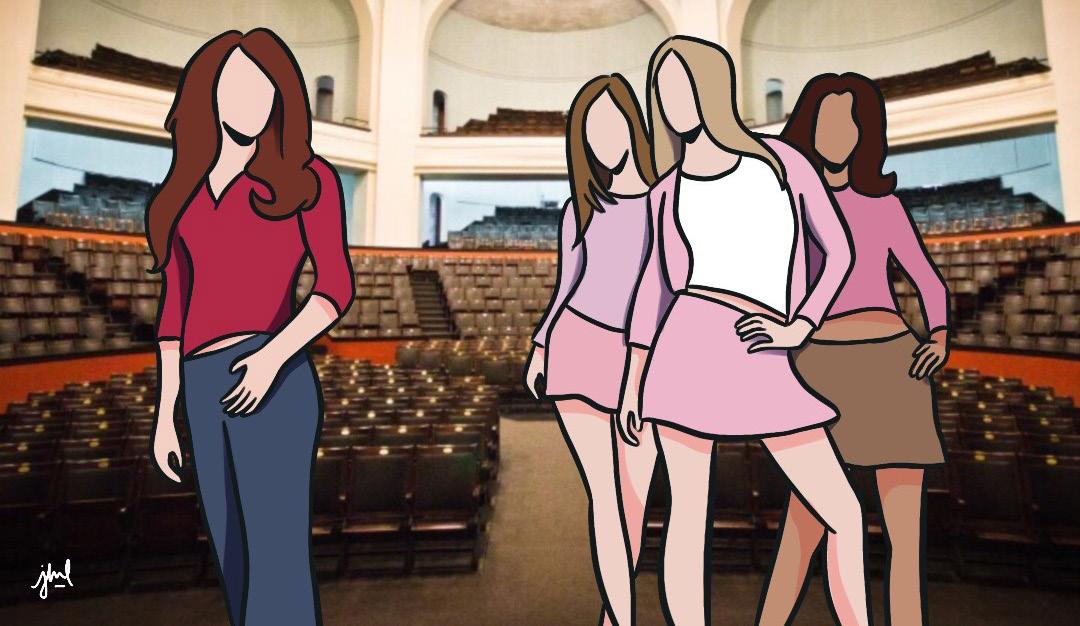
ship with a theatre company. They will be part nering with Howland to offer mentorship op portunities within the show — there are student assistants, and there will be students working backstage — but also beyond the show. Over the course of the year, the companies will col laborate on things like panels and one-on-one mentorships.
And Howland’s signature reading group may even come to campus. “[The reading group] has been our key community initiative this whole time,” said Seline. “We did it online for a long time, which was incredible during the pandemic. And we’re hoping to bring it back in-person at Hart House this year… [It’s] a free, open com munity event where anyone who’s interested can join in and cold read a play… It’s really fun, very low pressure… an opportunity that is open for anyone interested to get together and engage with theatre together in a very fun and casual way.”
But before any other plays can be read, it’s time for some Chekhov. “Chekhov is so beauti ful and why I’m so excited for us to share it right now is because that line between joy and heart break is so aligned,” said Seline. “It feels so pres ent and active in our collective lives… and I feel that the reason for people to get back together again, right now, is to collectively… feel these big things, laugh big laughs, and leave having shared something immense and beautiful.”
Three Sisters starts previews October 26 and opens November 2. Student tickets start at $15.
&
October 17, 2022 thevarsity.ca/section/arts-and-culture arts@thevarsity.ca
Popular movies like Mean Girls have been filmed on the UTSG campus.
BERNARDA GOSPIC AND JESSICA LAM/THEVARSITY
Spencer Lu Associate Design Editor
U of T’s rich and expanding architectural land scape started back in 1859 with the completion of its first permanent building: University College (UC), designed by Cumberland & Storm, an ar chitectural firm established in 1852. Since then, a wide variety of buildings encompassing styles across many different architectural movements have found their home on campus. Modern struc tures complement and play off of older buildings in this ever-growing architectural zoo.
A mixed bag of styles
Although U of T was established as the succes sor to King’s College — an Anglican university that was established through the same grant as U of T and closed in 1848 — in 1850, the UC building was completed in 1859. For nine years, the school existed in temporary spaces. When UC was com pleted, it marked the beginning of U of T’s archi tectural contribution to Canada. The collection of U of T’s colleges soon joined the ranks one by one, with each college’s architect given stylistic freedom when designing their buildings.
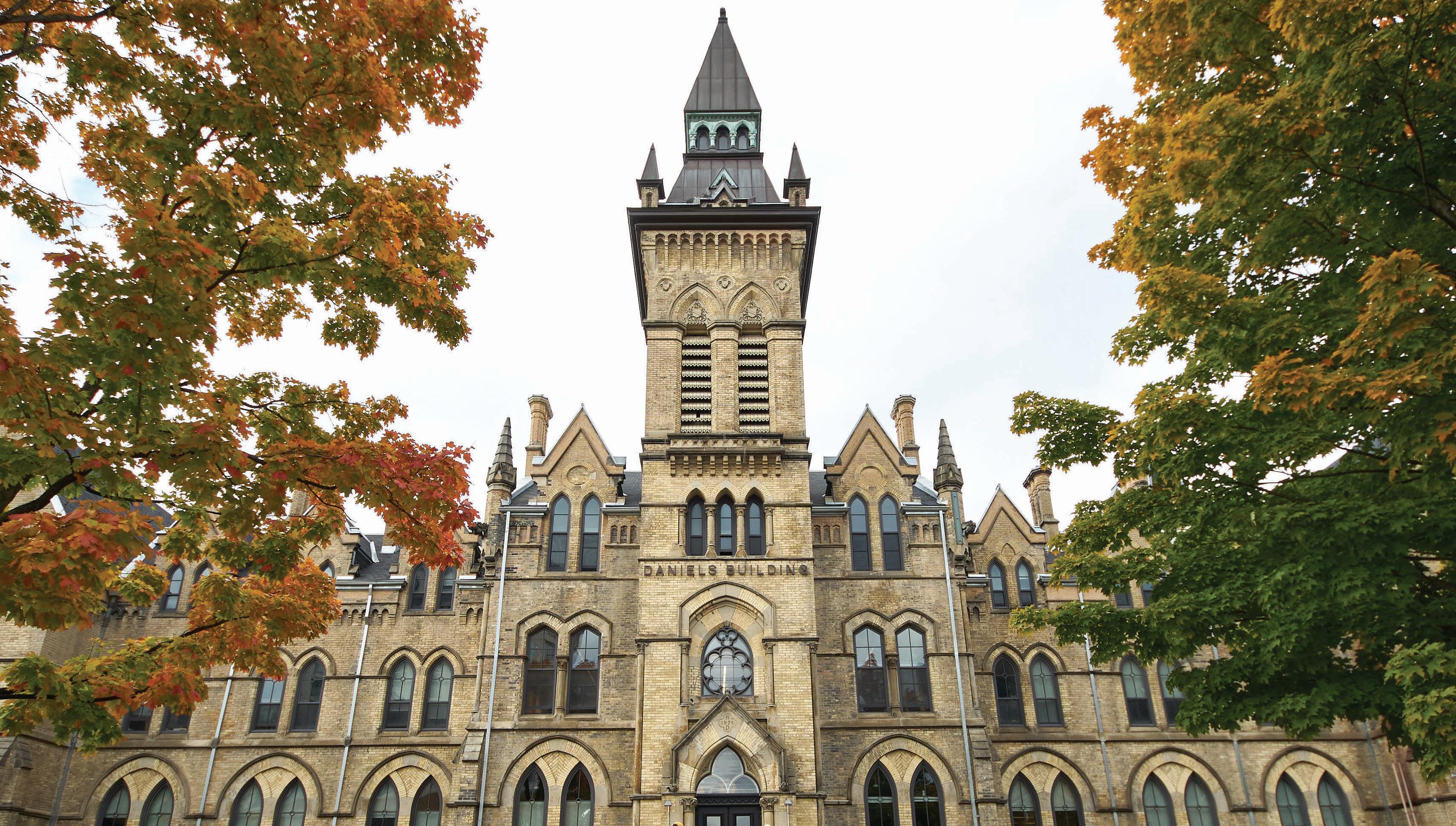
U of T’s eclectic approach has resulted in a motley collection of styles that define the old build ings on campus. UC is a unique medieval Roman esque Revival-style building; St. Michael’s College consists of the Gothic Revival St. Basil Church, built in 1856, alongside various historic houses of the 1890s era of different transitional styles; Victo ria College, built in 1892, embodies a Richardso nian Romanesque style; and Trinity College, built in 1925, is built in a Collegiate Gothic style.
Moving further into the twentieth century, we got New College in 1962, Innis in 1964, and Woodsworth in 1974, all built in a modern style with brick, a rather traditional material. This type of homage to the past is characteristic of U of T’s campus and is readily apparent in Innis College’s incorporation of a renovated nineteenth-century Victorian townhouse’s facade, situated alongside a modern addition built in matching orange brick, steel, and glass.
Next to Innis, the Max Gluskin House, renovated in 2008, also artfully integrates historic houses by linking them with glass and steel additions along with an intentionally rusted bright orange steel fa cade in the courtyard that color-matches the older orange brick buildings around it. This meeting of
old and new is also present in the iconic Daniels building, which is home to U of T’s architecture faculty. Daniels is composed of the old One Spadi na crescent building, built in 1875, which remains intact and is facing the south along with a grand and new modern added segment from 2017 fac ing the opposite direction to the north.
Meanwhile, Massey College offers a different take on incorporating the past into modern struc tures. Designed by Ron Thom and built in 1963, this project was a nonstandard blend of tradi tional and modern styles resulting in a truly unique building defying the architectural laws of its time. The modern school of architecture at the time re jected ornamentation and instead put significant emphasis on exploring new forms and materials, while traditionalists differed by following a strict set of forms with no interest in abstraction. In the 1960s, a modernist building with ornamentation was just as unheard of as a traditional building with abstract design — yet Massey College gracefully brings abstract forms and ornamentation together in a traditional courtyard layout, making it a unique example of what could be considered early post modernism.
The Medical Science building, built in 1969, is one example of U of T Brutalism built with heavy consideration for architecture’s relationship to pub lic art. The sculpted concrete exterior facade was painstakingly crafted by artists Ted Bieler and Rob ert Downing and covers a majority of the building, blurring the line between art and architecture.
Another piece of pure modern architecture on campus is Robarts Library, built in 1973. Although popularly considered a horrendous sight by much of the student body, others believe the building is a powerful and intricate example of monumental Brutalism.
In an interview with The Varsity, Professor Emeritus and former Dean of the Daniels Faculty of Architecture Larry Richards pointed out that the library’s composition around the triangle and ge ometry is well planned out, and the rough type of concrete used commands respect. Richards also noted that Robarts does admittedly lack in design with regard to its relationship with the ground.
“I like Robarts a lot, [but] what was never very good about [it] is the way it meets the ground,” Richards explained. “You have these kind of mon umental steps going up here, to the main level, but the real entries where everybody went in were sort of what looked like back doors or fire escapes.”
Regardless, Robarts is certainly an architectur ally impressive and ambitious structure that brings character to the UTSG.
Reworking the old Making sure older buildings are up to date is an other important part of honouring the traditional architecture on campus. UC has gone through many repair renovations throughout its tumultu ous past, including, recently, the 2018 accessibility and library renovation being led by Kohn Schnier architectural firm.
The ever-growing list of building standards means UC was due for an accessibility make-over. Although this would normally consist of a standard technical update to the building, Kohn Schnier takes a few clever design approaches to make this mundane task interesting.
A huge part of this is the elevator addition. The challenge of integrating an elevator into a stylisti cally medieval building was playfully met by the addition of the dark elevator shaft on the outside, decorated with large scales resembling the skin of a dragon. Although visibly modern, the zoomor phic addition works seamlessly with the building’s medieval style.
While some buildings get to be renovated, not all of them get to be saved. Sid Smith, built in 1960, is one such example. Although at first glance, the building doesn’t look like anything special, this concrete structure holds a well endeared position in the history of Toronto architecture as one of the first examples of the modern concrete slab and podium form and radical structure.
Its planned redevelopment, however, brings up the very complicated topic of heritage. Right across the street is the Sir Wilson Residence of UC, built in 1954, which is also another important building from the modern era designed by Mathers & Haldenby — the architectural firm that worked on Robarts. This building has designated protec tion status under Part IV of the Ontario Heritage act for being architecturally significant as an exam ple of the twentieth century Georgian Revival style.
Sid Smith, on the other hand, does not have any level of heritage recognition, despite its his tory. Part IV of the Ontario Heritage allows for the designation of culturally or architecturally valuable buildings after a registration process to receive le gal protection from demolition.
Richards spoke of the complicated value judg ments that come with heritage. While old build
ings such as Sid Smith or UC can certainly be preserved in their original form throughout renova tions, preservation is a very costly process, and unless the building is of outstanding value, some times a smarter choice would be to redevelop the building completely. Despite the architectural significance of Sid Smith as an iconic modern trail blazer, parts of the building require demolition in order for the site to meet environmental and ac cessibility standards.
Ultimately, renovation complications are a mon ey problem. There is no right or wrong answer, but at this early stage of planning, we don’t even know the architect and design associated with the rede velopment of Sid Smith yet. For now, there is little we can do but watch and wait.
A brighter future
The university provides a comprehensive list of its upcoming architectural projects to the public. The ambitious Landmark Project is one of the more obvious ones at UTSG. It aims to recon struct King’s College Circle to include Canada’s largest urban geothermal field and an under ground parking lot while making the surface level more walkable. This geothermal field aims to save an estimated 15,000 metric tons of greenhouse gas emissions per year, which will dramatically contribute to sustainability on campus.
Another project that Richards is particularly excited for is the Schwartz Reisman Innovation Centre being constructed at University Avenue and College Street, which will add a new pyrami dal building to the character of U of T.
Richards brought up an important consid eration for U of T’s future built environment: the advancement of technology and a future in vir tual reality spaces. We’re already seeing the emergence of a virtual learning space, especially through the COVID-19 pandemic, and they will continue to grow. As virtual spaces develop, im plications of the coexistence between physical and virtual worlds suggest new challenges and possibilities.
However, it is important not to forget the pur pose served by history and physical structures. Although classes can be taken from home, that doesn’t mean they should be. Physical architec ture has an important role as a sort of historical museum of the university, and the spaces pro vided for both in-person or virtual learning should be designed to spark educational inspiration.
thevarsity.ca/section/arts-and-culture OCTOBER 17, 2022 13
The many styles of U of T architecture How U of T came to look as it does today
The Daniels Faculty of Architecture, Landscape and Design. AUGUSTINE WONG/THEVARSITY
Emily Cheng Varsity Contributor
Two years ago, I attended my first ever lecture at university. Everything about university was foreign and nerve-wracking to me. My school uniform era had finally come to an end. I was out of the small secondary school classroom — not in a grand lecture hall, but back in my room, connecting to my new classmates over Zoom.
It was my first time meeting my professor. He introduced himself to the class: “Hello everyone! My name’s Jeff. Please don’t call me Professor, call me Jeff.”
That was new. In fact, it was so foreign to me that it took me almost half of the semester to finally be able to comfortably call him Jeff. I questioned the reasons for my discomfort. Was I too prudish?
Being born and raised in Hong Kong, I have been bilingual my entire life. Cantonese Chinese is my mother tongue and the language I speak most of the time back home. I have also been learning English for as long as I can remember. Interestingly, Cantonese spoken by Hongkongers usually follows the grammatical structure of Cantonese Chinese with English words and phrases mixed in — a pretty representative example of how unique and hybridized Hong Kong culture is. In a nutshell, Hong Kong culture has a base of traditional Cantonese culture mixed with British and Western cultures.
As in traditional Cantonese culture, respect for seniority is prominent in Hong Kong. When we address people in Cantonese, it is important
to address people with honorifics to show respect to elders. My parents taught me to never address elders by their first names because it is impolite and offensive.
In secondary school, not only was I told to address the staff by their title and last name, but I also learned that there were consequences for breaking this rule. Back in third grade, a fellow classmate of mine called a teacher by her name in a playful manner and was scolded by her in front of the whole class. As a result, I felt a sense of wrongness in addressing Jeff by his name that was deeply rooted in me. It felt impolite and wrong for me to address Jeff without his title. I was not too prudish — I was just not used to it.
Clearly, this mindset is not limited to when I am speaking Cantonese. When I address an elder in English, in addition to their preferred name, I try to find the best honorific according to their age and seniority. It doesn’t hurt to be a little more formal and polite, right?

However, from my experience in the Englishspeaking world, I find that people prefer that others drop all honorifics and call them simply by their preferred names. My American-born, English-speaking cousins call their siblings and cousins simply by their names. When I visited them last summer for the first time in seven years, one of my cousins whispered to my aunt, “How do I call her?”
“Sum Yue (biu2 ze2). You’ve always called her this.”
“That’s so long. It’s weird.”
‘Biu2 ze2’ — i.e. 表 — is an honorific for an older female cousin on the maternal side. It might




sound distant and awkward for my cousin, who is seven years younger than me, to call me by my name with an honorific. It might seem too formal and give off a sense of hierarchy to non-native Cantonese speakers. For me, I like being called ‘biu2 ze2’ a lot — not because it fluffs my ego or marks me as a superior, but because it makes me feel closer to my cousins. It is the honorific that emphasizes our relationship as cousins, highlighting the sense of family, especially with relatives I have not seen in years.
Conversely, as the youngest cousin on my mom’s side, most of my cousins are older than me by at least fifteen years and I only see them during festive family gatherings. Calling them ‘biu2 ze2’ or ‘biu2 go1’ — i.e. 表 , an elder male cousin on the maternal side — reminds me that they are family rather than some strangers with whom I am having dinner. I find that honorifics are especially helpful in making me feel more in touch with distant relatives from my extended family.
English speakers usually only use the words ‘aunt’ or ‘uncle’ for their relatives. However, I address all middle-aged people by ‘auntie’ — (ji1 ji1) in Cantonese — or ‘uncle’ — (suk1 suk1) in Cantonese. Not only does it draw me closer to strangers, but it also shows respect for elders. Because, for Cantonese speakers, the terms ‘auntie’ and ‘uncle’ are not limited to relatives, I like to joke with my non-Cantonese speaking friends that everyone in Hong Kong is my auntie or uncle.
Apart from honorifics, when it comes to preferred names for friends, I noticed that
Cantonese speakers of our generation prefer to use their full names, while English speakers prefer their first names or nicknames. My Cantonesespeaking friends and I call each other by our full Chinese names. Even if I called a Cantonesespeaking friend by their English name, it would be by both their first and last name. Their full names in English usually have three syllables, echoing the three-syllabic characteristic of most Chinese names. Using their full names may sound formal and a little aggressive — sometimes it is — but it shows how comfortable we are with each other.
On the other hand, when I introduce myself to strangers, I usually go by my English name. It sounds more casual in an English-speaking environment, but personally, it feels more formal in a Cantonese-speaking environment. I have not heard any of my close friends back home call me Emily in so long that I don’t even recall the last time any of them did that. It would feel so foreign to hear my English name come out of their mouths. There is a sense of distance when Cantonese speakers call me by my English name — maybe it is the language, or maybe I am just used to people calling me by my Chinese name.
I am, of course, comfortable with both Cantonese and English ways of addressing people. I flip the switch depending on where I am and to whom I am talking. Still, I like to embrace my hybridized mindset of addressing people. It is a way for me to keep in touch with the hybridized culture I grew up in and my mother tongue — Cantonese — while being away from my home.
arts@thevarsity.ca14 THE VARSITY ARTS & CULTURE
PANAWEE SAKULWANNADEE/THEVARSITY
In translation: What should I call you? Honorifics, and calling friends by their full name to indicate intimacy ,
The forgotten parts of U of T
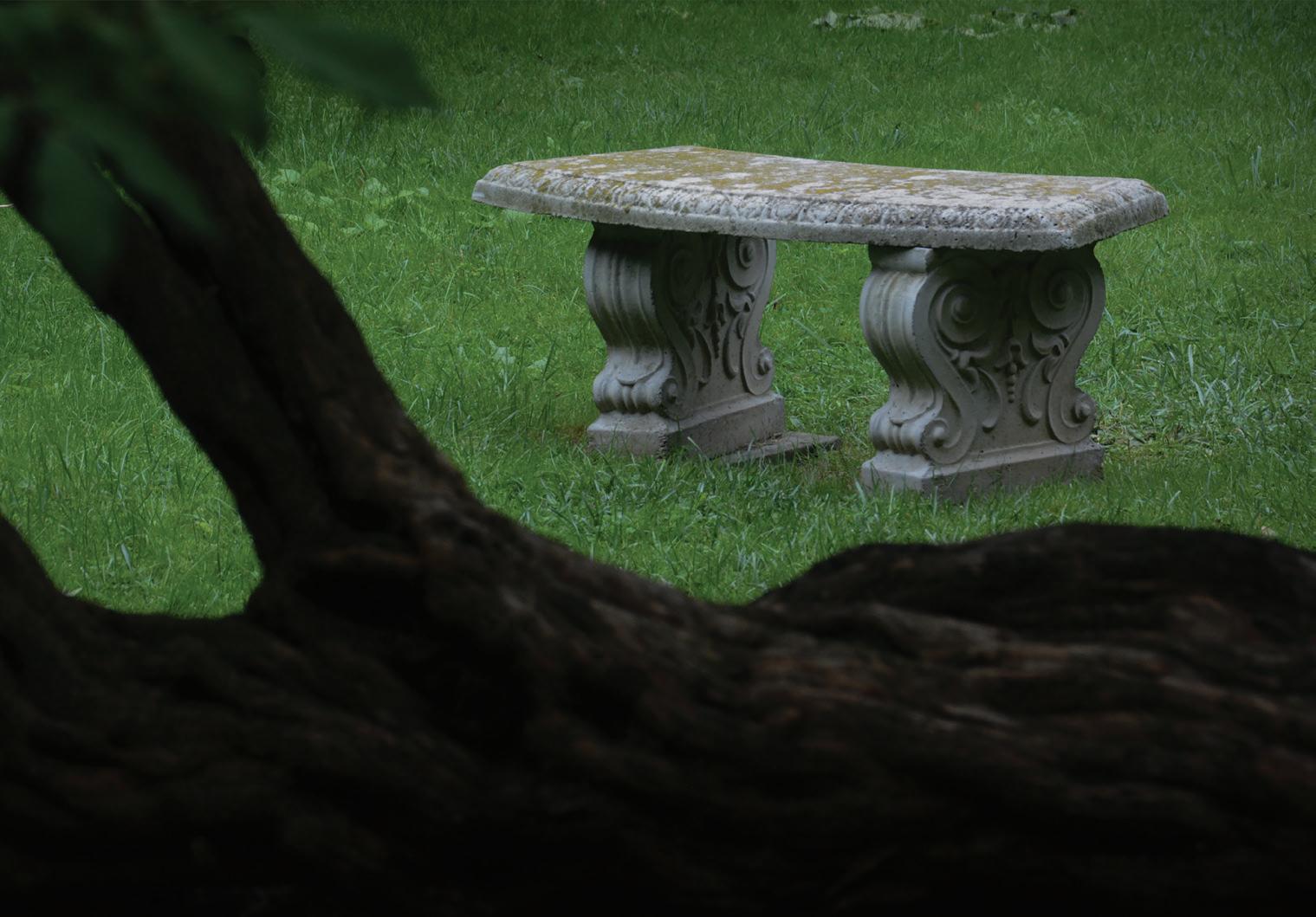
Reflecting on the quieter, hidden parts of campus as a first-year student
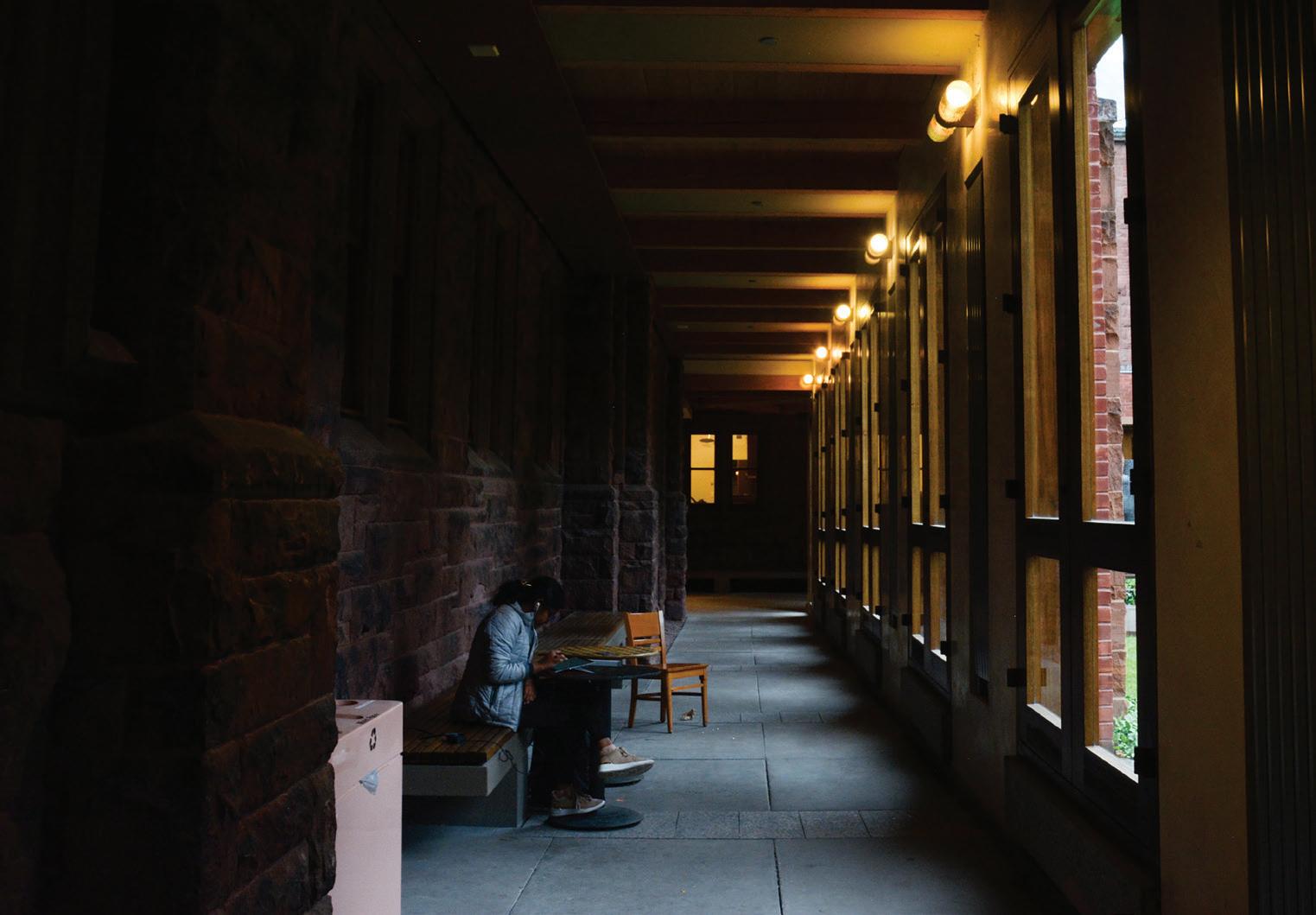
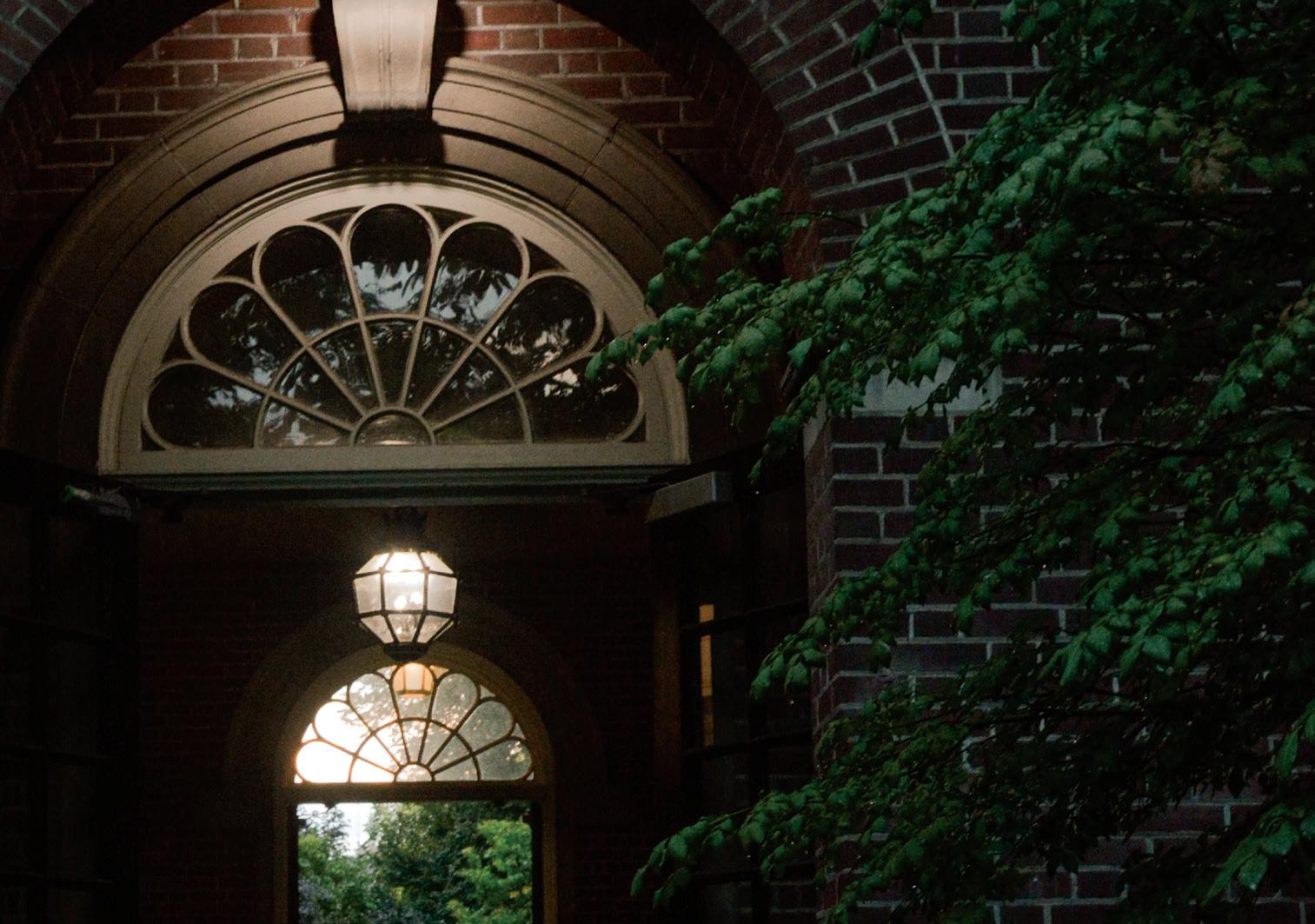
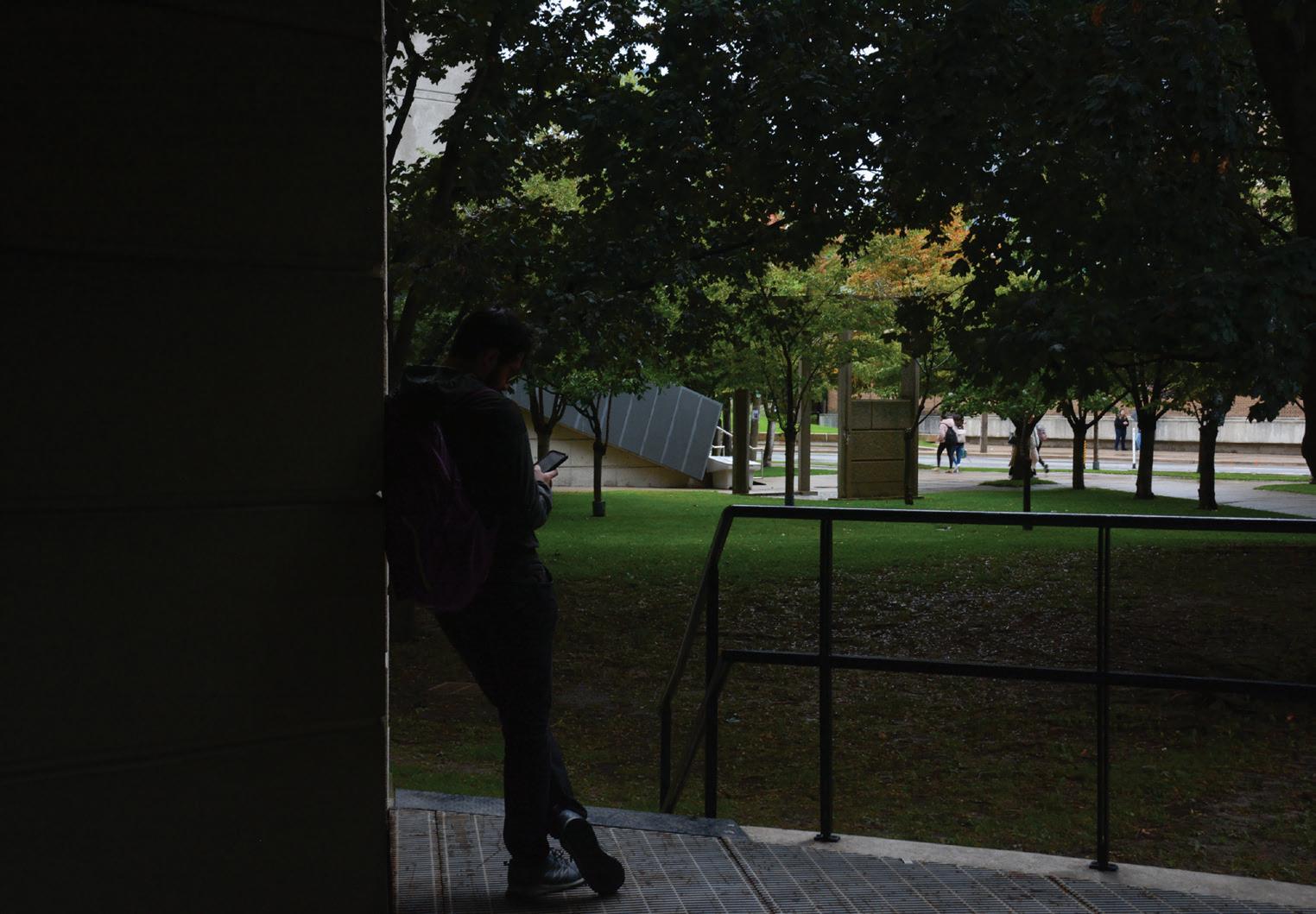
 Zeynep Poyanli Associate Photo Editor
Zeynep Poyanli Associate Photo Editor
Looking out of the window from Morrison Hall’s seventh floor can be quite intimidating. On your left is Robarts library, always with its lights on, which ironically hints at butchered sleeping schedules while the light itself at night marks the presence of life and the hope that comes with it. Then there is the Back Campus Field, the place where the word “community” is diversely interpreted by different
groups. For the sports players, the field provides a sense of connection with their teammates; for me, a first-year student who has stepped onto the campus — and into Canada — for the first time after a 10-hour direct flight, it’s a reminder of what I feel deprived of.
To find myself at a place on the campus, I have been following herds of students around between classes, in an attempt to see where the ambiguity of not knowing where they’re going would take me. So far, everywhere I have gone has carried
traces of remembrance and appreciation from the student body. However, student presence went beyond mere remnants in bigger places with more classes like the University College building — the corridors were teeming with laughter.
On a large campus like U of T’s, I assumed that some places would be destined to be forgotten — neglected, disturbingly quiet, and lost. However, I’ve realized that the forgotten parts of the university are more abstract than the buildings themselves. I see them in the reflection
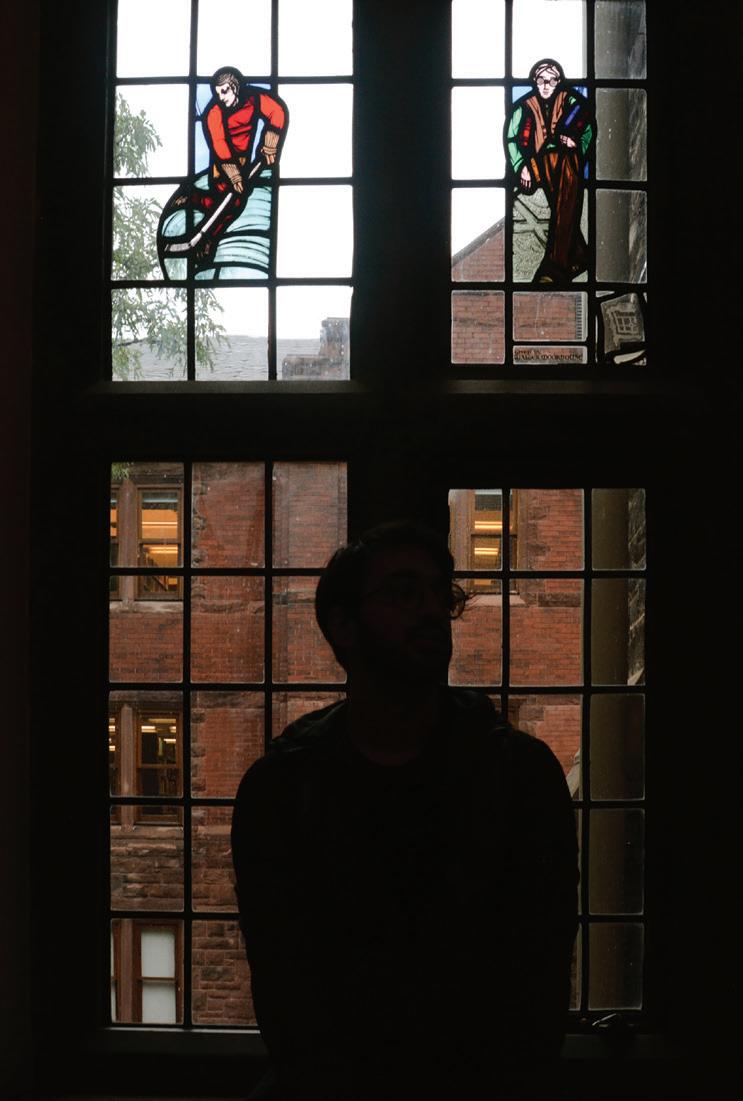
of the light posts in front of Hart House after a day of rain, in the students living their coming-of-age moments in the alleyways of Trinity College, and in the empty marble benches that the Knox College backyard birds make use of much better than us students.
In my ode to the forgotten parts of U of T, I find a subject in the gloom and solitude of daily experiences we overlook too often because of busy schedules, which are feelings I sometimes appreciate and more often despise.
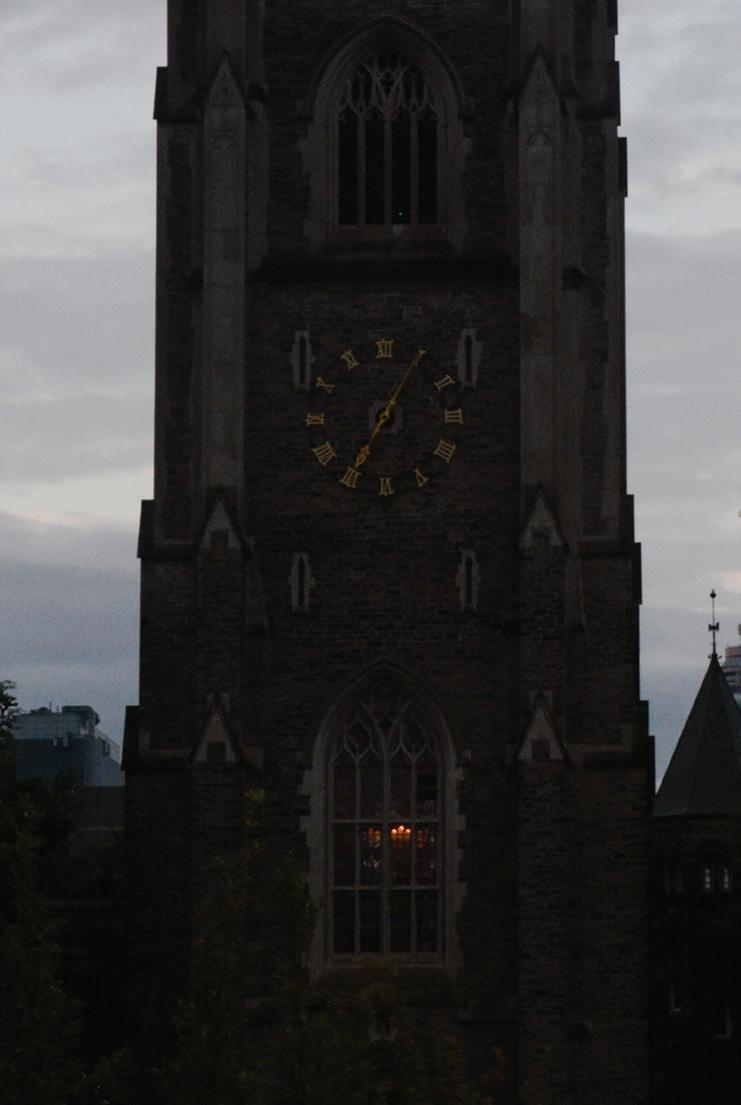
Photo October 17, 2022 thevarsity.ca/section/photo photo@thevarsity.ca
A student peering through the window.
It is easy to find oneself immersed in the hidden bookcases in the library.
The backyard feels different after the sun sets.
A student looking at his phone while others pass by.
The glasswork enclosing the entrance of Whitney Hall.
Marble benches in the backyard of Knox College.
“I love a good place to hide in plain sight”
— “Punisher” by Phoebe Bridgers.
What does a world without colours, shapes, or faces look like? The curious cases when visual perception goes wrong
Salma Ragheb Varsity Contributor
It’s hard not to take all the complexities of our visual perception for granted. Human vision generally allows us to simultaneously perceive many attributes of an object, like colour, shape, and texture. We can perceive features and recognize people, differentiate them from one another, understand their facial expressions, and associate them with how they might feel. But when these modes of perception are impaired, they can create similarly complex effects.
In An Anthropologist on Mars, neurologist Oliver Sacks writes about a case of a painter completely unable to perceive colour. In another case explored in Melvyn Goodale & David Milner’s Sight Unseen, detailed by Sacks, that of patient DF, a man wakes up from a coma and realizes he can no longer see shapes. Aimee Bender — a surrealist fiction writer — writes about a boy who cannot recognize faces and
Although that last case is fictional, these stories all talk about real impairments in visual perception that some people actually experience. The Varsity interviewed Jonathan Cant, an associate professor in the Department of Psychology at UTSC who studies cognitive neuroscience and visual perception, about what causes all of these visual impairments — and what they can tell us about the human brain.
Cerebral achromatopsia: the case of the colourblind painter
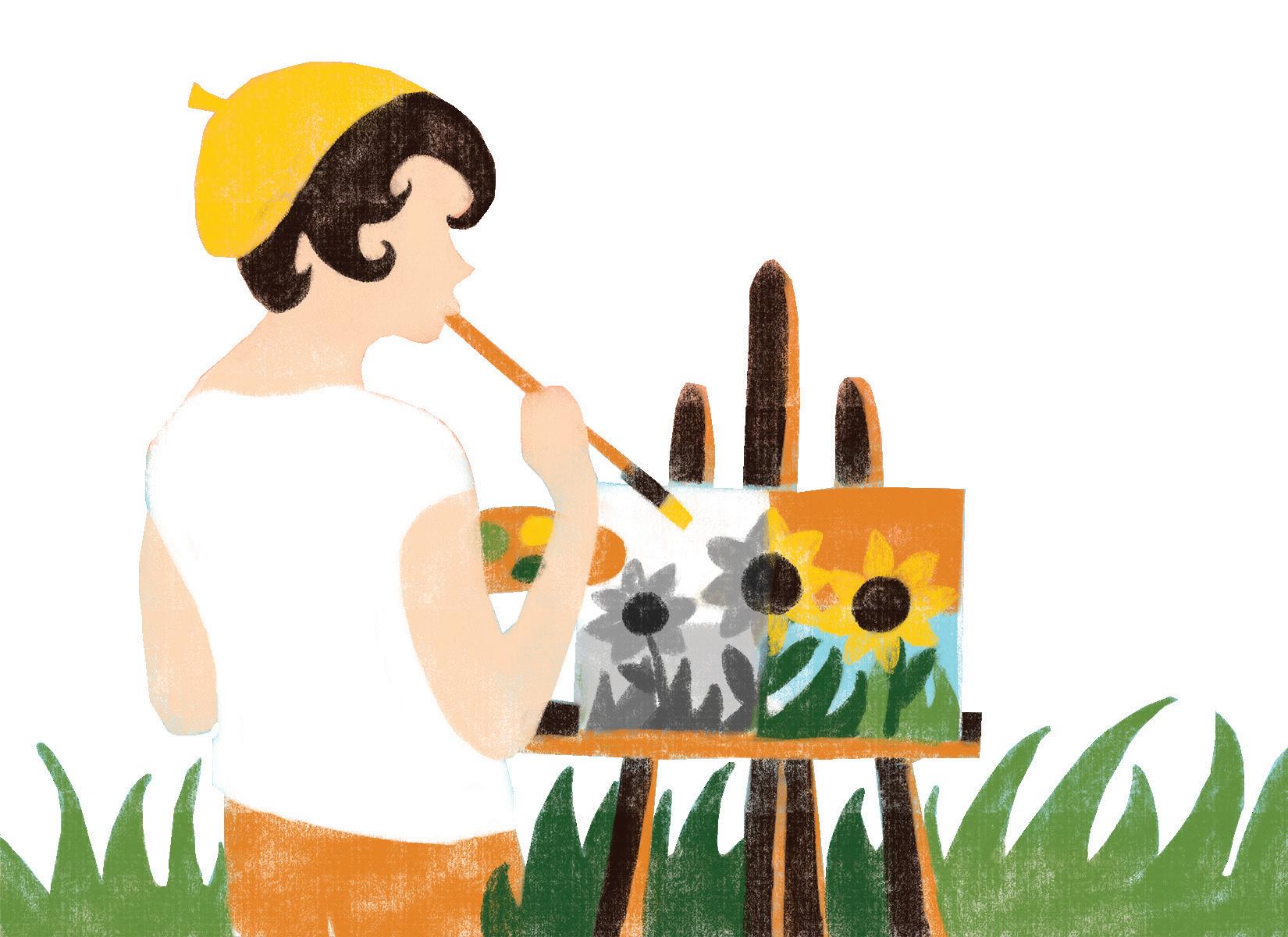
A painter, Mr. I, had been driving when he was hit by a truck on the passenger side of his car. After the accident, he saw the world in greyscale. This had been a strange case for the late 1980s because colourblindness was understood as genetic and congenital, not a condition acquired later in life.
Also, most colourblind cases were characterized by an inability to distinguish between red and green, which was due to defects in the cones, the photoreceptor cells that allow us to perceive colour. And because cones are part of the retina, this is called retinal colourblindness. As such, colourblindness had been attributed to defects in the retina, not to
What made this case different was that not only was the painter unable to see colour, he was also no longer able to imagine it.
It was unclear whether the damage was to his brain or eyes. However, his inability to even imagine colour pointed to the brain as the damaged
structure.
Mr. I was a professional painter — he knew the colours of everything. But he couldn’t see or imagine the colours that he once knew; after the accident, he only knew colours by their names. Imagine how frustrating this must feel: you are certain you know something, but you can’t see it or remember it; you absolutely no longer have access to it, even in the form of memory or imagination.
Total colourblindness, like the case described in The Case of the Colourblind Painter, is called cerebral achromatopsia and is caused by bilateral cortical damage — damage of the colour-processing areas in both hemispheres of the brain.
In the interview, Cant said that the region of the brain most commonly affected in cerebral achromatopsia is the lingual gyrus and fusiform gyri in the occipito-temporal cortex.
Such was the case for the colourblind painter: the secondary visual cortex in both hemispheres, specifically visual area four, which is in the fusiform gyrus, was bilaterally impaired. The occipital cortex is at the back of your brain and the temporal cortex is near your temples. The lingual and fusiform gyrus are regions that span from the back of the brain to the bottom sides of the brain, near your temples.
Cant added that cerebral achromatopsia is acquired — in contrast to retinal colourblindness, which is genetic — and occurs after a lesion to the cortex caused by stroke, head injury, epileptic seizure, or any incident that might disrupt certain regions of the brain. Cant added, “If the lesion to a brain is to the right hemisphere near the lingual and fusiform gyrus, the patient would lose colour vision for the opposite visual field,” and vice versa. Cant continued, “If you have bilateral lesions in the same general region on both sides of the brain, you would acquire full cerebral achromatopsia.”
It is also not always the case that full cerebral achromatopsia patients lose their ability to imagine colour. But some patients with full cerebral achromatopsia do lose visual
imagery for colour. And this was the case for the colourblind painter.
Prosopagnosia
Bender, who writes surrealist fiction, wrote a short story called “Faceless” in The Colour Master, a short story collection. The story is about a boy who cannot see the faces of the people around him. Until my interview with Cant, I thought this had been a surrealist fiction story with a case that Bender had made up, but to my surprise, face blindness is a real neurological disorder!
This impairment in recognizing facial features is called prosopagnosia. The common area lesioned in cases of prosopagnosia is the ventromedial — front and middle — region of the occipito-temporal cortex, including the lingual and fusiform gyri — similar to the regions commonly lesioned in cerebral achromatopsia.
Visual form agnosia Cant also mentioned the case of patient DF as the one that spurred his interest in visual perception. After carbon monoxide poisoning, patient DF woke up from a coma and couldn’t see shapes anymore but could see colour just fine, implying that shape and colour are processed independently in the visual system. This agnosia was caused by damage to the occipital cortex of patient DF.
U of T courses on vision perception and impairment
If these cases interest you, there are some courses about vision perception offered at the Scarborough campus of U of T. Most relevant to this topic is PSYC51 — Cognitive Neuroscience of Vision, which covers visual cognitive impairments like cerebral achromatopsia, visual form agnosia, higher-level perception of features, and defects in this perception like prosopagnosia. Also at UTSC, PSYC75 — Cognitive Psychology Laboratory covers classic cognitive psychology experiments and visual processing.
GLADYS LOU/THEVARSITY
The science behind Canada’s most popular sport
Breaking down the physics that makes up ice hockey
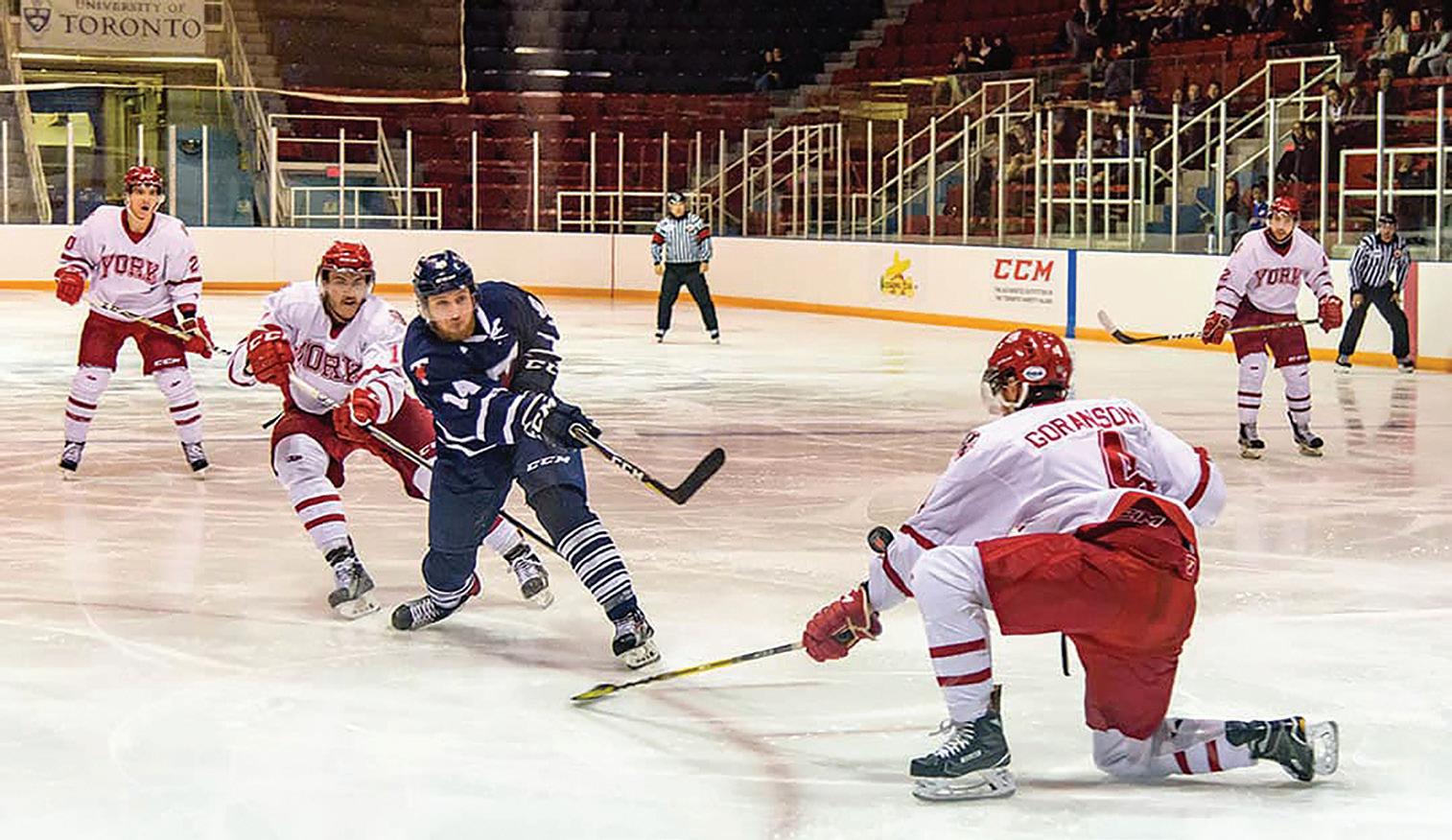 Harsimran Kaur Garcha Varsity Contributor
Harsimran Kaur Garcha Varsity Contributor
In 1984, Marc Garneau became the first Cana dian astronaut to fly in space. On his journey, he brought one very special object with him: a hockey puck. This isn’t a surprise to most Ca nadians as hockey is beloved by many, with an average of 460,000 viewers per game for the 2021–2022 season.
From the ice to the skates to the execution of the slapshot, science can explain all the aspects of Canada’s favourite game. Alain Haché breaks down all the details in his 2002 book, The Phys ics of Hockey
Keeping it cool
The science behind ice has been vastly studied, but the main factor to note is that it’s slippery.
In 1686, Sir Isaac Newton proposed three laws of motion, which explain how forces can act on an object. His third law of motion states that “every action has an equal and opposite re action.” When you run, for example, your feet exert a force on the ground, and the ground ex erts a force of equal magnitude in return, which allows you to push off.
However, the position of the feet and the di
rection of the force cannot optimally translate on ice due to the lack of adequate friction between skates and the ice.
Lace ‘em up!
Hockey skates are engineered to improve speed, agility, and control on ice. The blade on these skates has an arc-shaped groove at the end, which creates a small, empty area under neath the blade. An immense amount of pres sure is exerted onto this area, which results in the edges of the blade digging into the ice and providing grip to counteract the ice’s slippery na ture. As a result, the skater can accelerate and brake instantaneously.
Regular skaters and hockey players know how important it is to sharpen the blades on their skates. One important reason for this is braking. The sharper the blades, the deeper the blade can dig into the ice, which increases the frictional force when slowing down. When skaters want to brake, they must straighten themselves and turn one or both skates sideways. This motion provides a resistive force and, as a result, the blade scratches off a thin layer of ice.
However, even with perfectly engineered boots, skating is very difficult. Skating forwards entails orienting one foot at an angle with the toes pointing out while the other foot is gliding
forward. The foot at an angle will push off the ice and the ice reacts with its own force, allowing the skater to propel forward.
Scoring beauties
Scoring is essential to all competitive sports, and in hockey, the most exciting score is the slapshot. Invented by Bun Cook in the 1930s, the slapshot is a fierce interaction between the stick and the puck. Although the slapshot is great when a player is further away from the goal because of the extra speed, it does have a downside: it is not very accurate.
The slapshot consists of three stages. The first is the wind up, where the player brings the stick behind themselves and begins turning their torso. Then, the stick makes contact with the ice
and the puck. This action is crucial, because the force with which the stick hits the ice causes the stick to bend and load up with potential energy, also known as stored energy. Finally, this poten tial energy is converted to kinetic energy upon contact with the puck, allowing the puck to ac celerate.
NHL players can achieve immense puck speed when correctly utilizing the slapshot. In fact, the current record for the fastest slapshot is held by Zdeno Chara, who then played for the Boston Bruins. He scored a slapshot with a speed of 175.1 kilometers per hour in the 2012
All-Star Skills Competition! Perhaps, if hock ey players learn about the science behind the speed, they can set a new record in 2023.
Science October 17, 2022 thevarsity.ca/section/science science@thevarsity.ca
Exploring the physics behind the movement and shooting in hockey.
RUILIAN FU/THEVARSITY
Blues suffer 56–14 loss against No.1 Western Mustangs Varsity football team loses at home despite a solid defensive effort
Alaysha Merali Varsity Contributor
On Friday, October 7, the Varsity Blues football team gave up their two-game win streak to the Western Mustangs. The Mustangs were an un defeated 5-0 team going into the game while the Blues were 3-3, on the brink of a winning record.

The Blues had trouble getting past the 50-yard line in the first quarter, despite some rocket passes from quarterback Kinsale Phillips, to wide receivers Jake Oseen, and Jared Currie. When possession was shifted to the Mustangs, a lot of drives were made through the center of the Blues’ defensive line. The score stood at 28–0 for the Mustangs at the end of the first half.
In the second half, the Blues predicted some of the Mustangs’ plays well but could not get an interception. Despite this, the Blues played their heart out on defense, and made smaller plays in comparison to the Mustangs. The small plays they made were able to generate more first downs for the team. However, Mustangs outdistanced the

Blues during their plays, adding on three more touchdowns and bringing the score to 49–0 at the end of the third quarter.
The fourth quarter of the match was incredibly invigorating as the Blues attempted a comeback. Toronto’s players finally put their names on the board when Adam Williams reached the end zone with nine minutes left to go. A few minutes later, Scott Barnett reached his arm out right before he was tackled to push for a successful second touchdown, bringing the score to 56–14. With the last 45 seconds of the match remaining, Nicolas Greene received an eight-yard pass from Barnett to secure the third and final touchdown, putting an end to the 56–21 loss to the Mustangs.
“Today was a really good show [from] the U of T family, how much we believe in each other, and how much the culture has shifted, and where we can be down by those certain points and still go out and want to put 21 up,” said Philip in a postgame interview with The Varsity
There was definitely assurance and confidence from Philips that, if the Blues had more time —
The Raptors are ready to make the league fear the north this season
considering the way they performed in the last quarter — they might have been able to beat the Mustangs.
Going forward into their next game against Mc Master Marauders on October 22, Kinsale hopes
to stay positive about the outcome and put his ut most best into doing what he’s there to do. With a playoff spot on the line, the Blues will continue to make the community proud and play to their best abilities.
Lucas Sousa
Varsity Contributor
With the 2022–2023 NBA season set to tip off soon, the Toronto Raptors are hungrier than ever. Proving pundits wrong and silencing crit ics, the Raptors hope to improve upon their 48-34 record from last season.
After a disappointing first-round exit to the Philadelphia 76ers, the Raptors have focused on developing from within, instead of making flashy off-season signings and acquisitions. The Raptors were not extremely aggressive during the off-season, drafting Christian Kolo ko in the second round of the 2022 NBA draft and signing role players Otto Porter Jr., Juan cho Hernangómez, and Josh Jackson in free agency. While these players will most likely re main a part of the bench unit, they will provide much needed relief for a shallow roster.
The off-season could have been more ex citing, as the Raptors were a potential trading partner for former MVP Kevin Durant. However,
that saga ended with the two-time champion committing to staying with the Brooklyn Nets.
Because the roster has not seen much change, this season’s success will heavily rely on the progression of key cornerstones of the franchise. All eyes will be on the 2021–2022
Rookie of the Year, Scottie Barnes, who hopes to have a sophomore year better than his pre vious year. All-Star Fred VanVleet and All-NBA Pascal Siakam are also expected to continue their stellar performance, while last season’s breakout players Gary Trent Jr. and OG An unoby hope to take the next step in their de velopment.
This development is very much needed. The Raptors have been a force to be reckoned with but their offense has its faults. Offensively, the Raptors were 20th in points, 29th in assists, and are in the bottom half of the league in all shooting efficiencies. Major improvements must be made, both in scoring and in efficiency.
This past season, Siakam and VanVleet combined for 32 per cent of the Raptors’

points. If you include Scottie Barnes and Gary Trent Jr., that number rises to 58.95 per cent. Simply, the bench should be better if the Raptors hope to repeat their success from the 2018–2019 season.
For this upcoming season, the Raptors are predicted to start with Fred Vanvleet, Gary Trent Jr, OG Anunoby, Scottie Barnes, and Pascal Siakam. Their bench availability is more dependent on how players play during the pre season.
The backup shooting guard position is the weakest point in this team. However, that might be by design. The Raptors’ positionless nature was put on full display during the series with the 76ers, where Raptors’ head coach, Nick Nurse, put out a lineup of one guard and four forwards to accommodate for VanVleet’s injury. Given their lack of guard depth, it seems that the experimental project will be a leading phi losophy at the Scotiabank Arena this season.
Sports October 17, 2022 thevarsity.ca/section/sports sports@thevarsity.ca
The team hopes to develop young talent to improve on an impressive campaign last year
Kinsale Philip braces for impact against an oncoming linebacker. COURTESY OF SEYRAN MAMMADOV/VARSITY BLUES MEDIA
JESSICA LAM/THEVARSITY; COURTESY OF ALL-PRO REELS/CC WIKIMEDIA
Pitch us at sports@thevarsity.ca
A reliance on pseudoscience
The science surrounding alternative and rehabilitative therapies
Andrew J. Stephen Varsity Contributor
Injury prevention and rehabilitative therapies such as cupping and Kinesio Taping® (KT tape) are points of contention in sports medicine and kine siology. Though scrutinized for legitimacy, these therapies have undoubtedly garnered attention in the athletic community.
Cupping therapy is an alternative therapy that dates back thousands of years and is generally
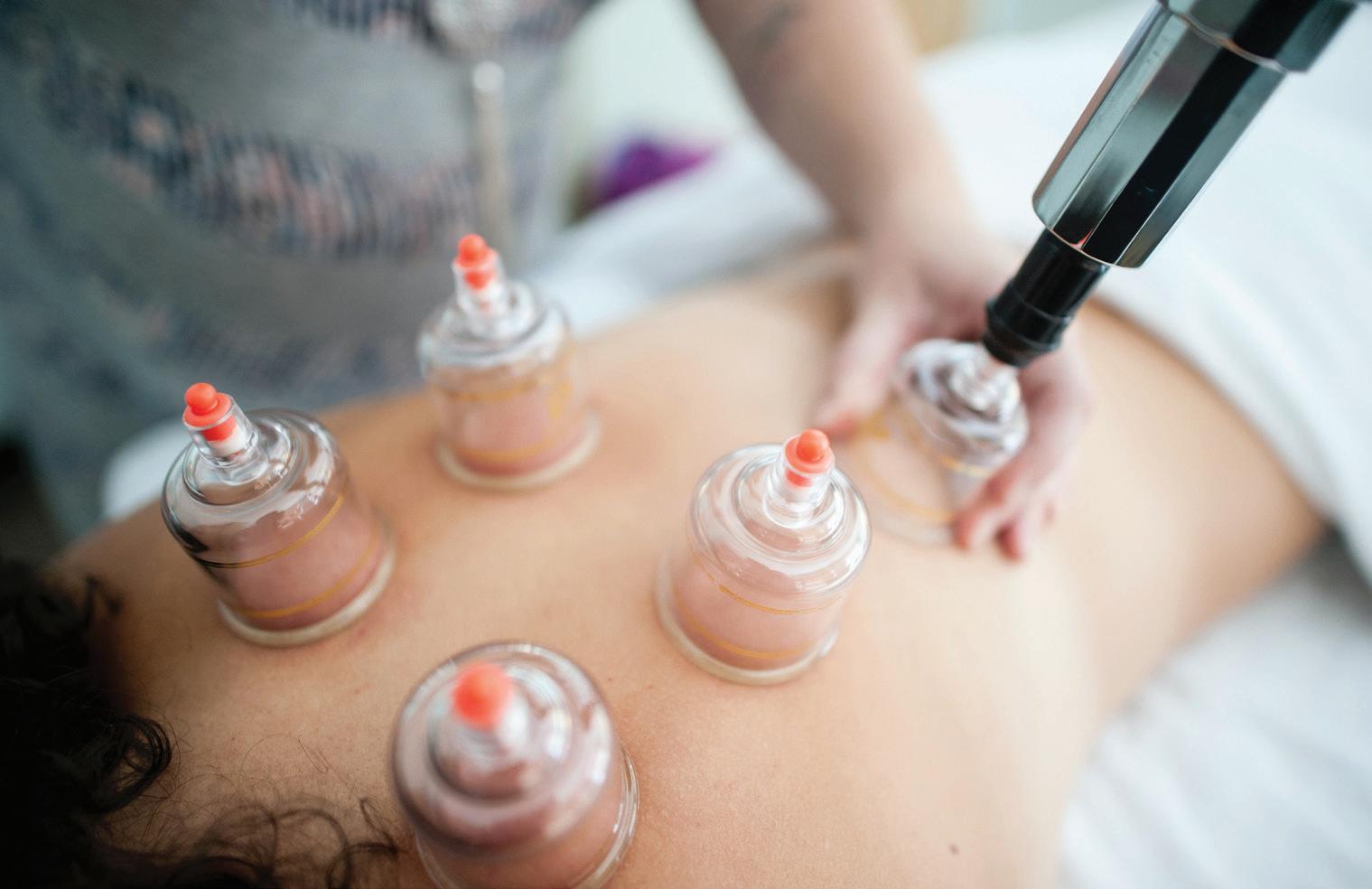
associated with the traditional medicine of several ancient Chinese, Egyptian, and Middle Eastern cul tures. Though modern cupping conventions have emerged, cupping traditionally involves varioussized cups typically made of glass.
These materials are used in tandem to create a vacuum on the skin’s surface, which suctions skin and muscle tissue to a localized area. The suction draws fluid to the localized area in an attempt to increase circulation. The cups are then removed, which reveals discoloration — due to damaged
blood vessels — underneath.
The world's most decorated olympian Michael Phelps brought cupping into the spotlight during his campaign at the 2016 Olympic Games in Rio de Janeiro, when he won five gold medals in the men’s swimming competitions.
During these games, Phelps was seen repeat edly with distinctive circular, dark-purple mark ings on his back, a common side effect for those who receive cupping treatments. The swimmer clarified that the markings were indeed from cup ping therapy, which he said was common prac tice for him in preparation for competition.
Perhaps this sight was enough proof to skep tics that cupping possesses some benefits relat ing to athletic performance, but what does the scientific community think? Many doctors and experts in sports science believe there is insuf ficient research indicating any benefits from cup ping therapy.
In contrast, others believe that the relevant scientific literature of the past decade has pre sented enough evidence to deem cupping as a valid means of treatment for some pain condi tions. Exactly how it helps is another question: many proponents of cupping therapy believe that it relieves pain by removing toxins from the body and therefore improving Qi energy flow. This no tion, however, is not scientifically proven and the causal explanation for the benefits acknowl edged in research studies remains obscure.
A more modern alternative therapy is KT tape, a drug-free form of athletic tape that, according to the company, improves muscular and joint fit ness while facilitating recovery of various injuries.
Two-time Canadian olympian and world beach volleyball champion Sarah Pavan is a huge pro ponent of KT tape. With her recent signing to join the company’s roster of sponsored athletes and her endorsement of similar products on so
cial media, Pavan has made her support for the product evident.
Similar to cupping therapy, there is a lack of high quality research examining the product’s efficacy in injury prevention and pain relief. A study published in the Journal of Physiotherapy concluded that the research team did not sup port using KT tape in clinical practice. Another study published in the Brazilian Journal of Physi cal Therapy deduced that the effects of KT tape on patients with non-specific low back pain were similar to those of a placebo.
Although most scientific literature does not support KT tape, some studies indicate that the product may decrease joint irritation and increase blood flow. The lack of convincing re search has not slowed down the product’s rise in popularity because much of KT tape’s promo tion comes anecdotally, from athletes like Pavan. A vital question is whether those who endorse the product are financially motivated or genuinely see merit in using the product.
Debates concerning rehabilitative therapies are not limited to those mentioned above. There is an abundance of therapies that face a similar amount of scrutiny, such as cryotherapy, which is a treatment that uses low temperatures, and in travenous hydration, in which fluid is injected into the body to treat dehydration. It is vital for thera peutics to face thorough investigation, especially when it involves the gargantuan athletics indus try. This investigation is particularly crucial when it involves claims of improving and prolonging an athlete's career.
Effective or not, there is clearly a demand for anything that may improve one’s rehabilitation and fitness, even if only slightly. Altogether, when it comes to these controversial therapies, their acceptance relies on consumer choice and one’s openness to the risk of relying on pseudoscience.
Verstappen enters US Grand Prix with F1 Championship Clinched What next for F1 after Verstappen’s second Championship Win?
Olivia Kairu Varsity Contributor
With four races left on the Formula One (F1) calendar, the sport looks forward to the Texan sun for the US Grand Prix (GP) after a spell of rain-covered races, including the championship deciding Japanese GP. The Dutch driver Max Verstappen has walked away from the Suzuka circuit as not only the race winner, but also as a two-time World Champion, pulling even fur ther ahead of Ferrari rival Charles Leclerc with a massive 114-point difference.
“Last year, all the way until the last race is probably the worst kind of feeling, going into that last race… this year, I think, it’s just been very, very different in emotions from the start, all the way through to the year,” Verstappen said to F1 Media, reflecting on his emotions over the course of the 2021 and 2022 seasons.
“But you know, both [seasons] are beautiful and both are, at the end of the day, nice to ex perience because it's nice also really to have always the pressure on and having to perform to your limit every single lap of the race,” he continued.
So with the championship decided, what more is there to look out for at the US Grand Prix?
It isn’t over for Verstappen, as the Dutch driv er aims to be on par with Michael Schumacher and Sebastian Vettel for the most wins — 13 — in a season in Austin, having already won his 12th race this season at Suzuka.
Red Bull expects that the Constructors’ Championship will be decided in their favour in Austin, with 619 points already on the table, making for a clean sweep this season for the Austrian-owned outfit. The only way Red Bull can be denied victory at the Circuit of The Americas is if Ferrari secures the top two steps on the podium.

With the Drivers’ Championship decided, the battle for second between Red Bull’s Sergio Pérez and Ferrari’s Charles Leclerc is ramping up with only one point separating the two driv ers. Following closely in a battle of their own for fourth is Mercedes driver, George Russell, cur
rently in P4 and Carlos Sainz, five points behind in P5.
The McLaren and Alpine rivalry, in which the victor will receive the unofficial victory of mid field leader, is heating up with the French team leading by only 13 points, leaving the papayaorange McLarens narrowly behind in fifth.
“They are in another league to us at the min ute. I'm happy we’ve been able to fight them so far into the season, it shows we’ve done a very good job in other areas, in reliability, in maxi mizing our performances, taking opportunities, and not making mistakes,” Lando Norris said, expressing his awe of the work McLaren has done to keep the fight close despite the many
difficulties they have faced.
“They must have done a lot worse than us in all of those areas to only just be ahead of us in the championship with the car they have. Not a surprise; it’s not a big fight at the minute be cause they are so much quicker, but we’ll keep trying and limit the points loss to them,” Norris continued.
Mercedes has announced an upgrade to their current 2022 W13 package that will de but in Austin, with hopes that it could deliver a win after an all but smooth season thus far. The eight-time Constructors’ Champions claim that the upgrade holds key information in the aerodynamic development of the 2023 W14
car. The Silver Arrows are still chasing a win to continue their streak of success each sea son, since the major rule change in 2014 that marked the beginning of the turbo-hybrid era.
Haas at home
The American-owned team Haas looks forward to its second race in front of a home crowd after the Miami GP debut at the begin ning of the season. However, the team faces a bit of housekeeping due to the vacancy in their 2023 lineup; Mick Schumacher has still not been confirmed and rumours of Nico Hulken berg’s return are echoing all over the paddock. The decision is set to be made in the lead up to the Grand Prix, where Haas has called a press conference to announce the way forward on Schumacher’s future.
What was dubbed “silly season” — due to all of the market rumours and contractual breaches — seems to have simmered down with the decision for the Alpine vacancy settled in favour of an all-French lineup, as Pierre Gasly joins Esteban Ocon for next season. Also, see ing Dutch driver Nyck de Vries in the AlphaTauri raises hopes of a Verstappen-De Vries Red Bull roster in the future for the Orange Army. The Alpine decision leaves current McLaren driver Daniel Ricciardo out of a seat for the coming season, as well as Canadian driver, Nicholas Latifi, who’s Williams is the last vacancy not decided upon.
IndyCar’s Alex Palou for Chip Ganassi Rac ing is set to make his F1 Free Practice 1 ses sion (FP1) debut in Ricciardo’s McLaren at the US GP. Also making his debut is Formula Two driver Theo Pourchaire, in the same FP1 session, sitting in Valterri Bottas’ Alfa Romeo, which marks the beginning of his new posi tion as reserve driver for the Sauber Academy driver.
Although the 2022 Drivers’ Championship de cided in favour of Verstappen and the Construc tors’ Championship will soon fall into the hands of Red Bull, there is still much more to look out for. From Mexico to Brazil and the exciting night skies of the Yas Marina Circuit in Abu Dhabi, this season’s checkered flag is far from being flown.
thevarsity.ca/section/sports OCTOBER 17, 2022 19
Cupping therapy is a popular form of alternative medicine for athletes.
COURTESY OF KATHERINE HANLON/UNSPLASH
The sun shines on the Circuit of The Americas. COURTESY OF HOVERVAN/CC WIKIMEDIA COMMONS

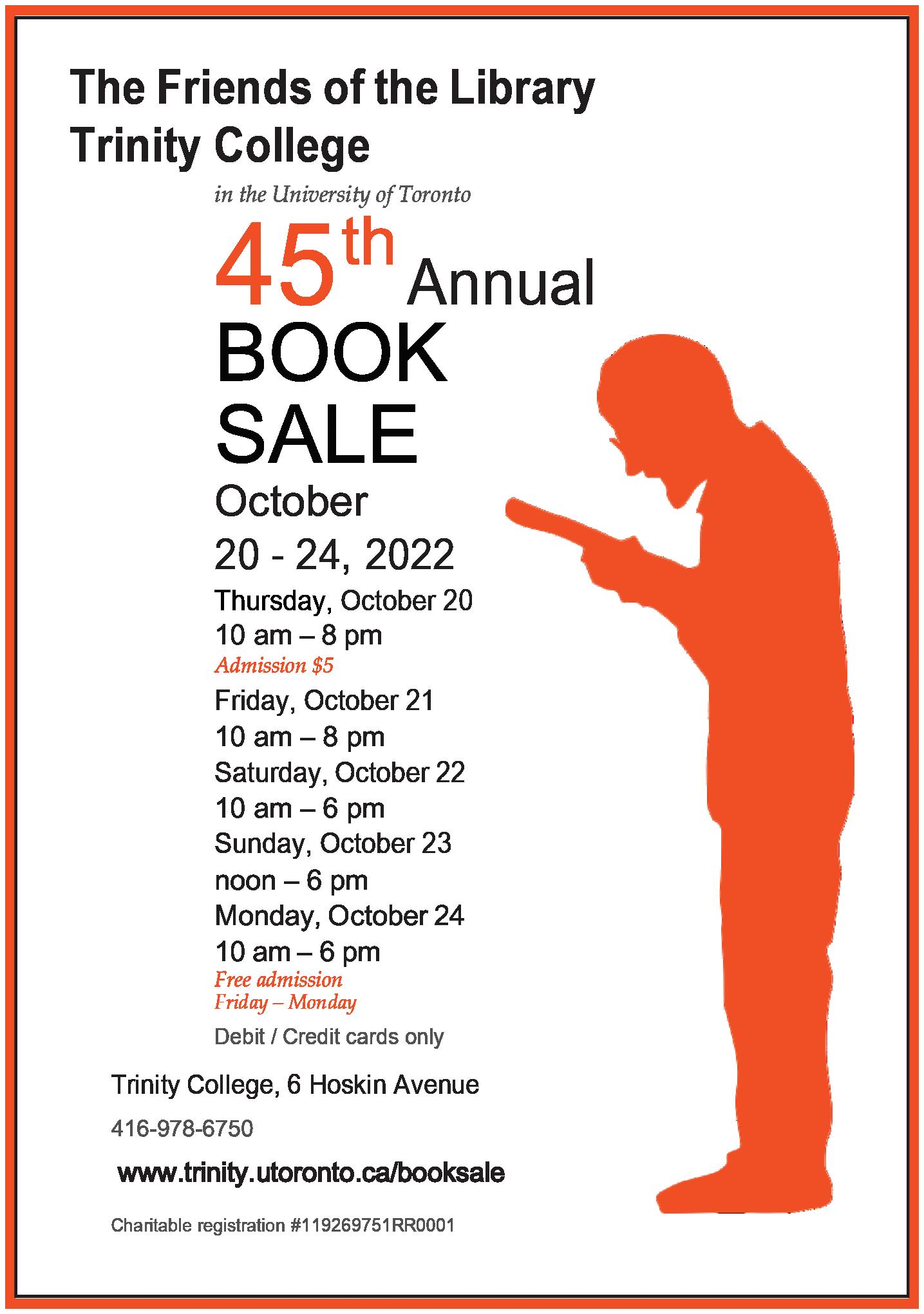


OCTOBER 17, 202220 THE VARSITY ADVERTISEMENTS Programming Lessons $15/hr Python C Java JavaScript Machine Learning 416-785-5115 students@cstutoring.com






















 Zen Nguyen Labour Correspondent
Zen Nguyen Labour Correspondent








 Zeynep Poyanli Associate Photo Editor
Zeynep Poyanli Associate Photo Editor



 Harsimran Kaur Garcha Varsity Contributor
Harsimran Kaur Garcha Varsity Contributor








